

The World Seemingly Has Changed Overnight: Countries and Markets Struggle with the New Global Fundamentals
• Globalization continues to be restructured: Trade tensions between China and the US/EU/IndoPacific have triggered a strong embrace of Industrial Policy major free market nations for the sake of “national economic security” (e.g., CHIPS Act in the US and EU, competition for critical mineral assets, etc.).
• Demographics are changing everything: India is now the largest population in the world as China begins to rapidly shrink. Africa is the fastest growing region of the world. Japan and many EU nations are seeing significant long-term shrinkage of their populations but are seeking to make up for it with immigration – as is the US. As for Russia: It is in a catastrophic demographic free-fall.
(Example: More than 100,000 IT professionals left in 2022. Worse, an estimated 900,000 Russians total have fled since the war started out of a total population of 142,000,000).
• Russia’s invasion of Ukraine changed everything: Geopolitical relations are in a state of flux in ways we have not seen since World War II. Moreover, global markets and businesses continue to scramble more than ever to adjust their strategies due to the impact on key sectors.
Ø In Summary: We are in a new age where the global and regional battle for access to commodities – especially agricultural, critical minerals, water, etc. – are driving what we could consider new Cold Wars - as well as real wars.

Sources: BBC, Fortune Magazine, Newsweek, Wall Street Journal, Worldometer
What is Happening to the Global Economy?
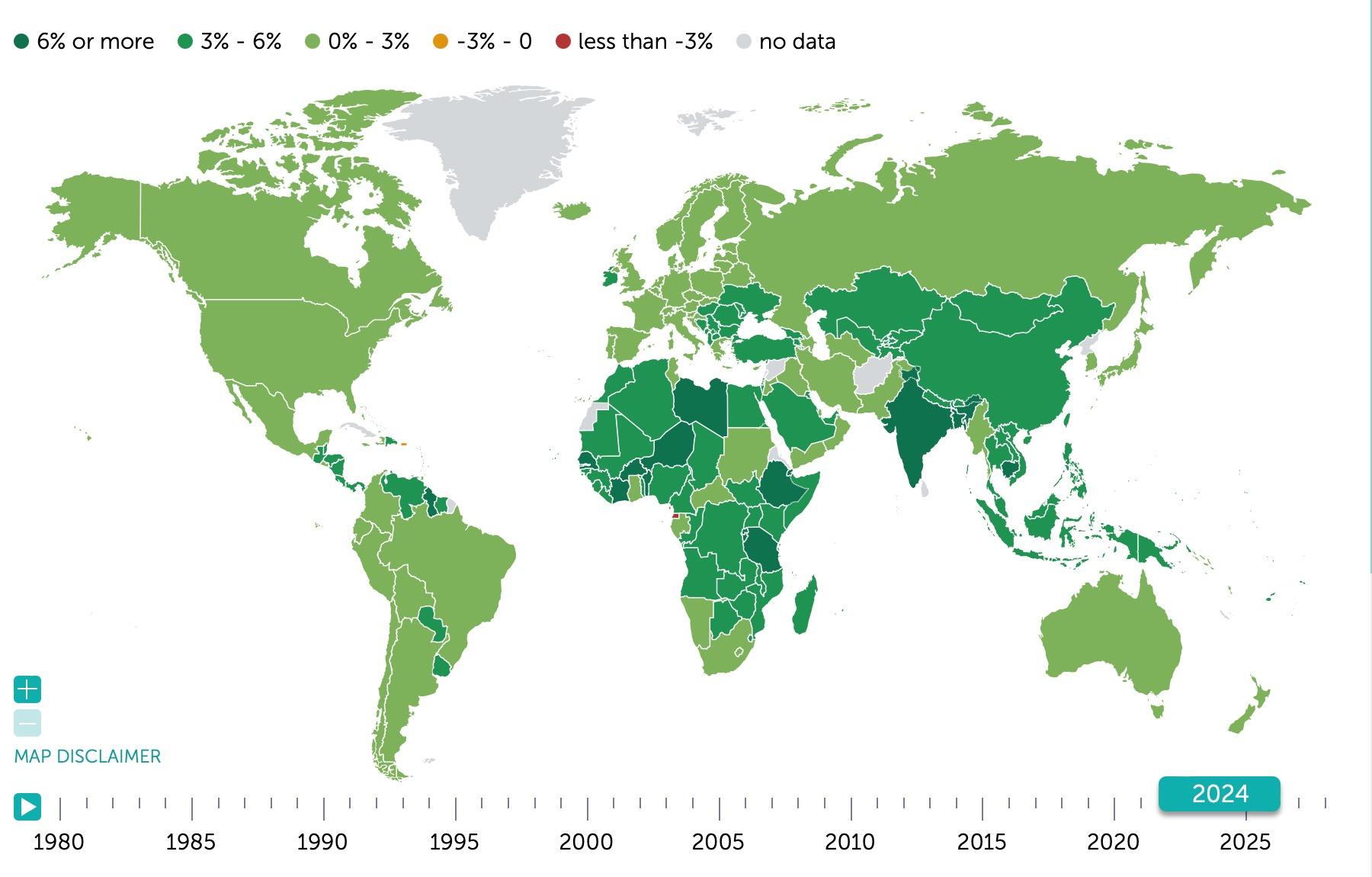
Source: IMF Datamapper

The Year of Elections –
76 in 2024: Change is Coming…

In 2024, more than half of the world’s population will have the opportunity to head to the polls to vote. That is more than 4.2 billion people having the opportunity to cast a ballot – the most in history. This includes eight of the ten most populous countries:
• The United States
• India
• Russia
• Brazil
• Indonesia
• Mexico
• Pakistan
• Bangladesh
2024 also brings new leadership to most global/regional organizations which have large for global markets:
• G7: (New Chair: Italy)
• G20: (New Chair: Brazil)
• APEC (New Chair: Peru)
• ASEAN (New Chair: Laos)
• BRICS (New Chair: Russia)
• CIS: (New Chair: Russia)
• NATO: Term of current Secretary General expires October 1.
• EU: (New Chair: Belgium (January – July);
Hungary (July - December)
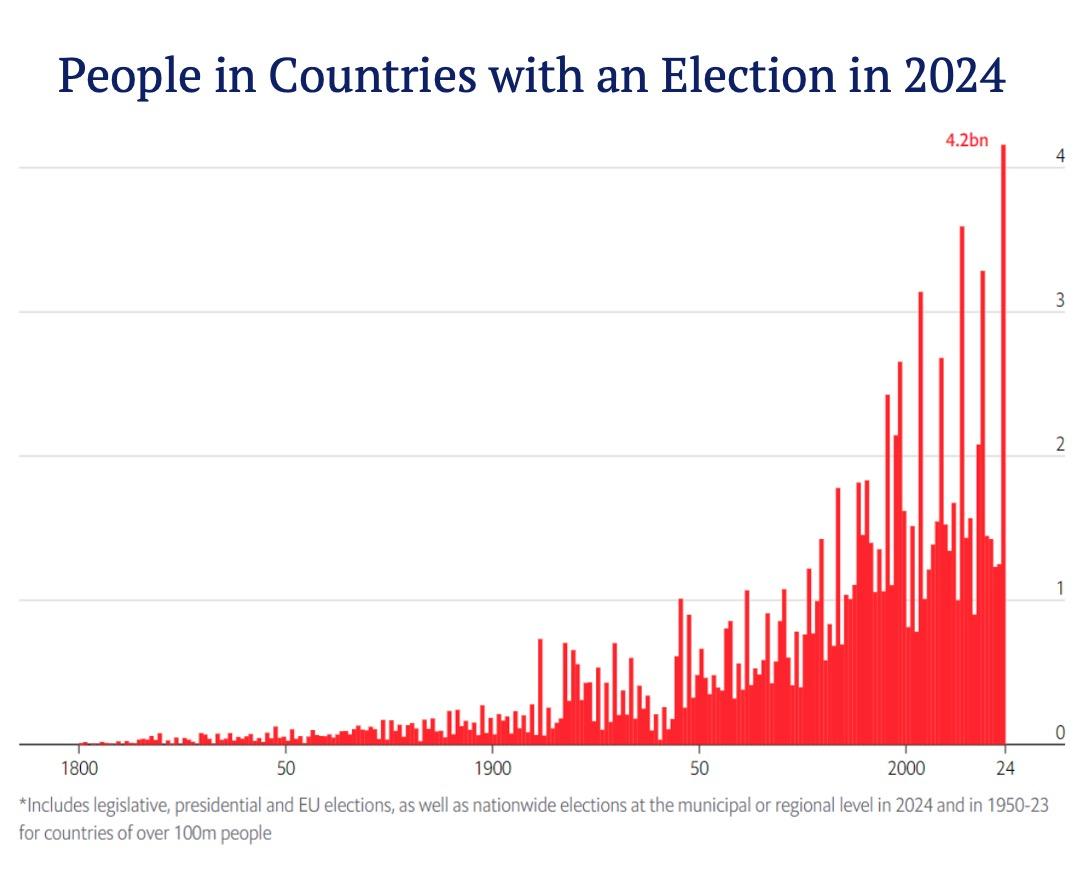
Source: The Economist
The New China: No Longer Destined to Dominate and Struggling With Major Economic and Social Risks
• The 20th Chinese Communist Party Congress in 2022 granted President Xi Jinping an unprecedented third term. In his acceptance speech, Xi’s focus: “Security.” He said the word 96 times. This goes to his view that the rest of the world is hostile to China – but it also goes to his worries about what is going on inside China.
• The Taiwan Invasion Risk: Worrisome but not likely in next three-to-five years. US assessment: An invasion would be Xi’s “last, worst choice.”
• A major casualty of Xi’s policies is the impact on the regional and global markets investing in China: Foreign Direct Investment has nosedived. And there is less transparency overall, especially of key economic data. This has been the trend under Xi for the last 12 years and is continuing.
• Watch the youth unemployment rate: Officially, it is at 21.3%. The real number is likely close to 30% and may be trending toward 40%. But we will never know because Beijing just suspended all reporting of that data.

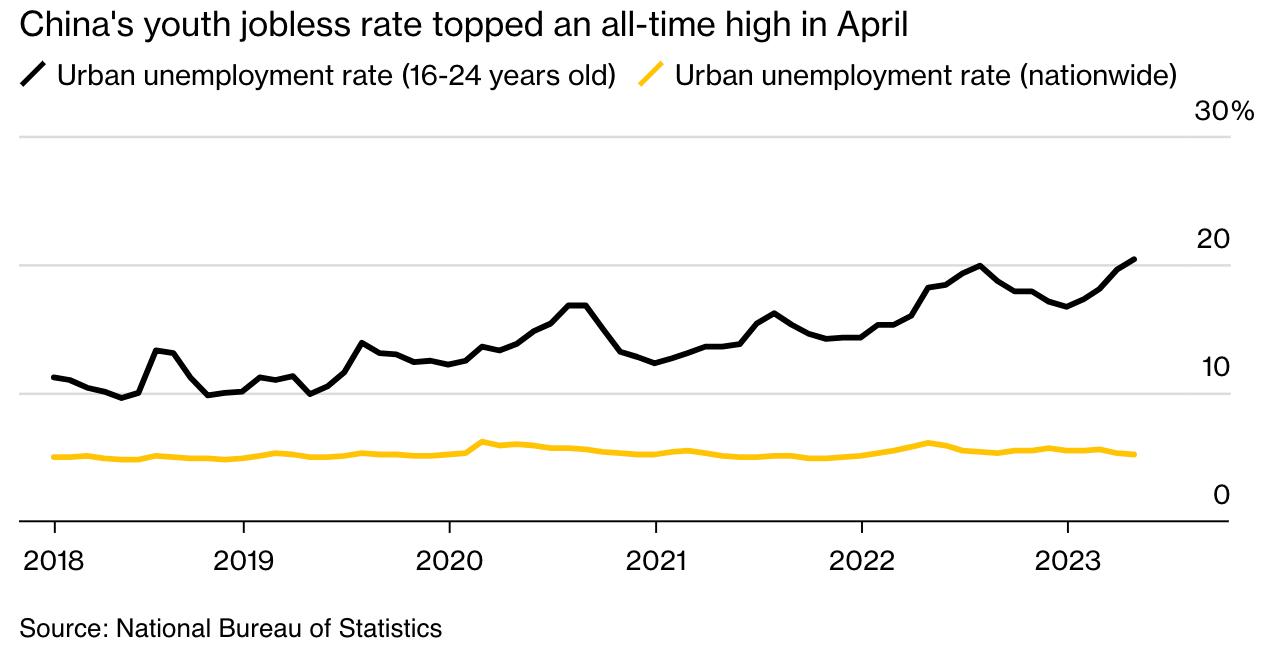
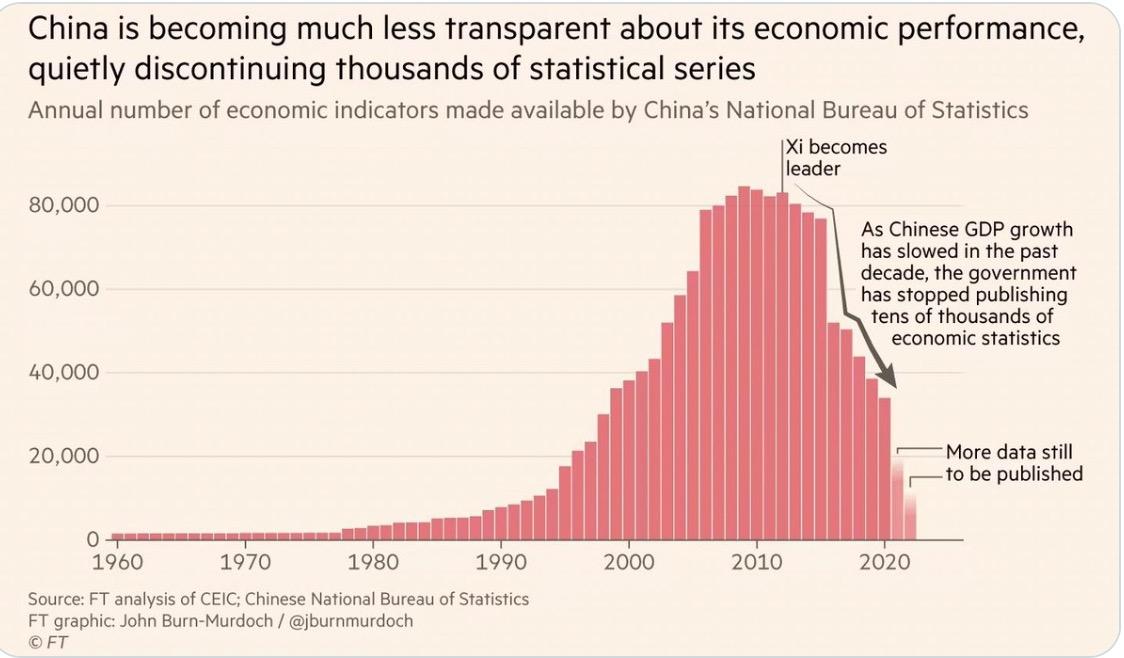
China’s Population Challenge: It is Not Getting Better Anytime Soon
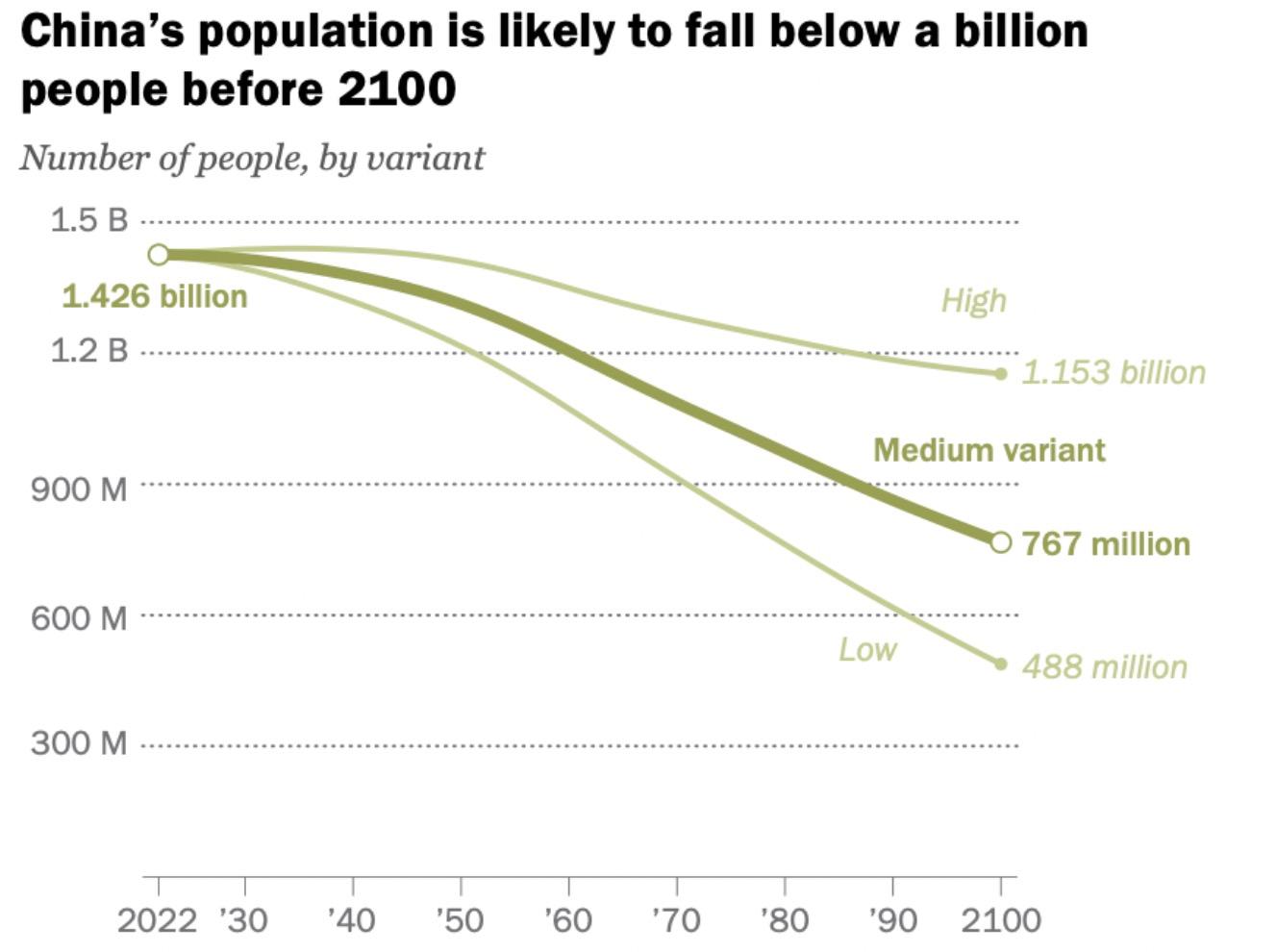

By order of comparison, by 2100
India is expected to have a population of 1.5 billion and the US is expected to have a population of 370 million.
Source: Gallup
Financial Outflows from China Continues to Grow
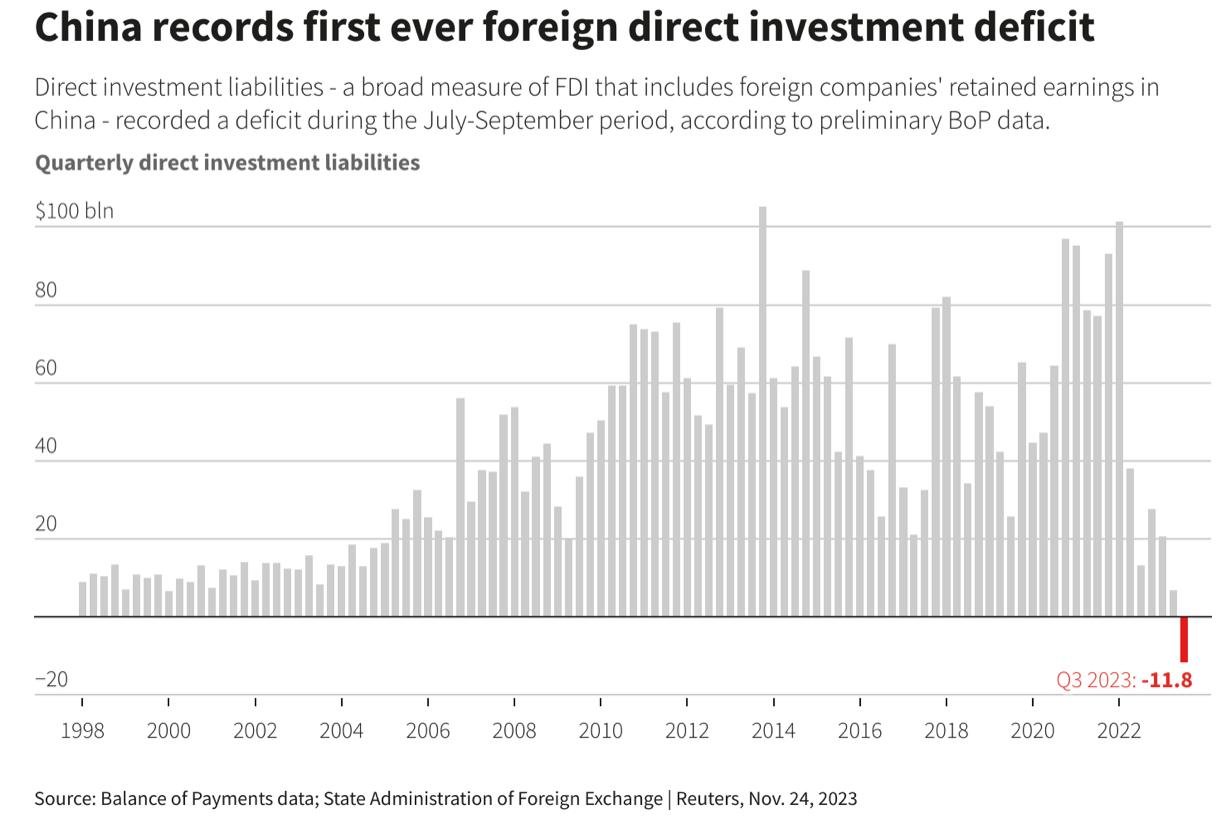

Nearly 90 percent of foreign money that flowed into China’s stock market in 2023 has already been pulled.
China’s Loss is India’s Gain: Rise of a Quiet New Superpower
• India is expected to be the fastest growing economy in 2023, experiencing 7.2 percent growth so far in 20222023. Its population is now larger than China’s, with the average age being 33 years old.
• We are beginning to see a growing outflow of manufacturing from China with a substantial amount of it moving to India. The reasons for going to India include:
o Low labor costs
o Government support
o Infrastructure
o Technology
o Education
o Rule of Law
• India is increasingly allied with the US and key IndoPacific allies (Japan, South Korea, Australia, Philippines) in China economic and security policy.
• The Quadrilateral Security Dialogue (Quad) is potentially the groundwork for a future mutual security/trade alliance between India, Australia, Japan, and the US.

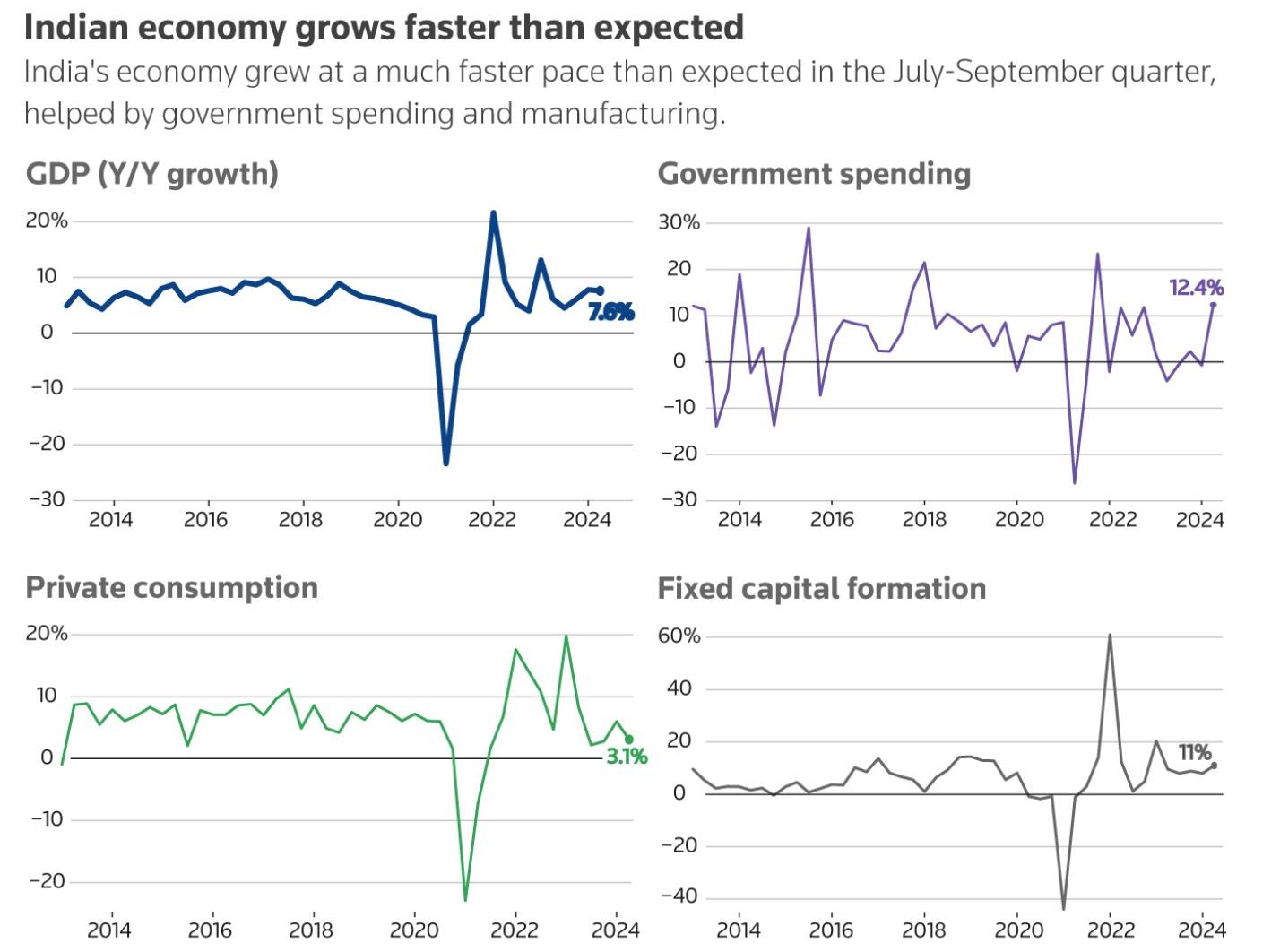
Sources: Reuters, Indian Ministry of Statistics
The Battle for Access to Critical Commodities
• Russia’s answer to breaking the Black Sea Grain Initiative last year is to essentially coerce Africa and Middle Eastern countries into supporting Russia’s war effort in return for agricultural sales. This past summer, Russian President Vladimir Putin held the Russia-Africa Leaders Summit. 43 African leaders were expected to show up. But only 17 made it.
• African nations are now increasingly wary of Russia’s heavy hand via the Wagner Group. The spate of coups in Africa just did not happen – Russia’s hand can be found in virtually all of them.
Ø After the coup attempt, Moscow said it was going to disband Wagner. That did not happen. In fact, large numbers of Wagner fighters were transferred to Africa after Wagner’s founder, Yevgeny Prigozhin, was killed.
• The same can be said for China – Belt and Road Initiative deals are costly and risk countries losing control of critical mineral export capabilities.
• What is at stake? The future of technological and energy dominance globally. We would also argue dominance of critical agricultural production.

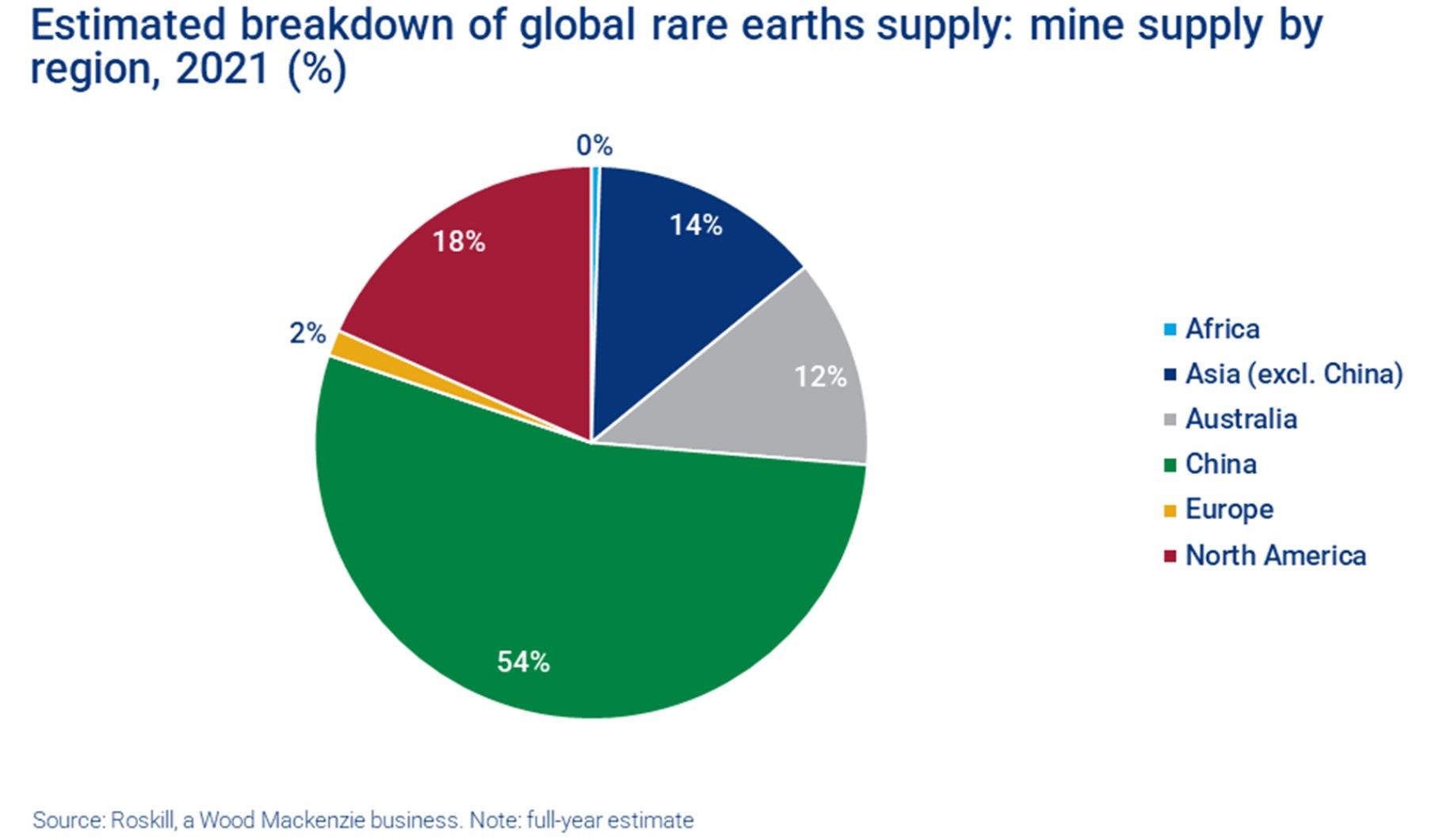
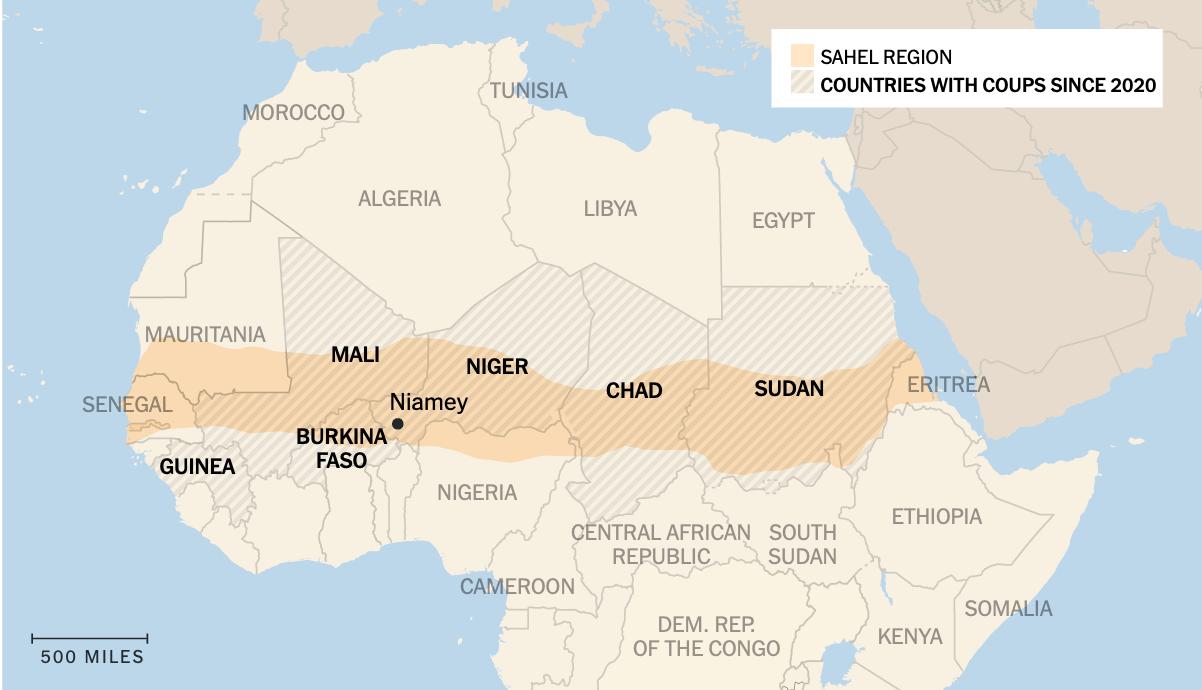
The Middle East After the the Horror of 10/7: The War Grinds On
• The grotesque attack on Israeli citizens on October 7 has likely changed the regional political and military reality in the Middle East for decades to come. But what should we be watching for and worry about?
Ø Iran: Do they directly engage with Israel? Do they unleash their proxy forces (Hezbollah and Shia militias via Syria)? We think likely not (but this may change following Monday’s killing of a senior Iranian commander in Syria) –Iran is too fragile internally and has too much to lose (control of Southern Lebanon and potential further internal unrest). Most of all: they cannot afford to lose their oil revenues. It is all they have financially going for them other than illicit trade (e.g., drugs, human trafficking).
Ø Other Middle Eastern Countries: Their verbal criticism of Israel is one thing but for Jordan, Egypt, Syria, Iraq, and Turkey, the worry is domestic populist uprising in support of Palestinians – which none of them have seen in any measurable way.
Ø Much depends on what happens in Rafah: How intense the battle, what happens to the refugees, etc.

Source: Congressional Research Service

The Red Sea Crisis (and the Panama Drought) Brings Inflationary Risk
• The ongoing military crisis in the Red Sea is bringing some new –but manageable – inflationary pressures and supply chain risks mostly to Europe.
• Commercial shipping operators face the stark choice of either rerouting around South Africa – adding as much as two weeks to shipping time – or being attacked by Houthi anti -ship missiles and drones if they traverse the Red Sea. Cargo insurance rates have swung widely on the back of increased attacks – rising as much as 300 percent.
• For the Houthi’s – a proxy militia of Iran – this is part of a larger strategy to sow chaos in the region and inflict maximum economic pain on the EU and US for supporting Israel. It also helps Iran’s ally, Russia. Moscow wants to put maximum economic pressure on the EU as Ukraine struggles for significant new economic and military aid.
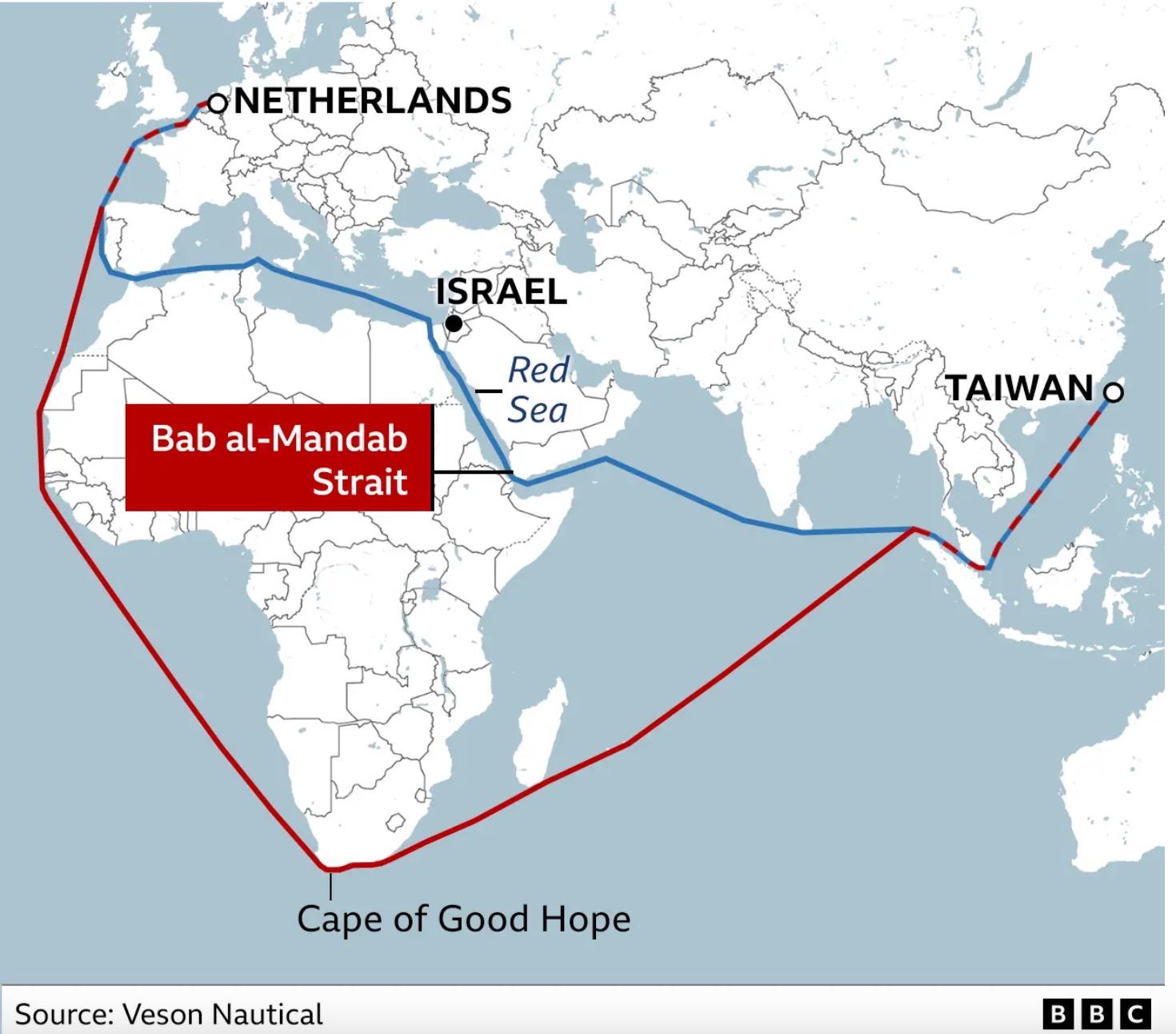

• Meanwhile, Panama – and the Panama Canal – are experience record-breaking drought conditions. The result? As few as eight ships a day can pass through the Canal, often after waiting two weeks for entry. Normally, 30-40 ships a day can pass.
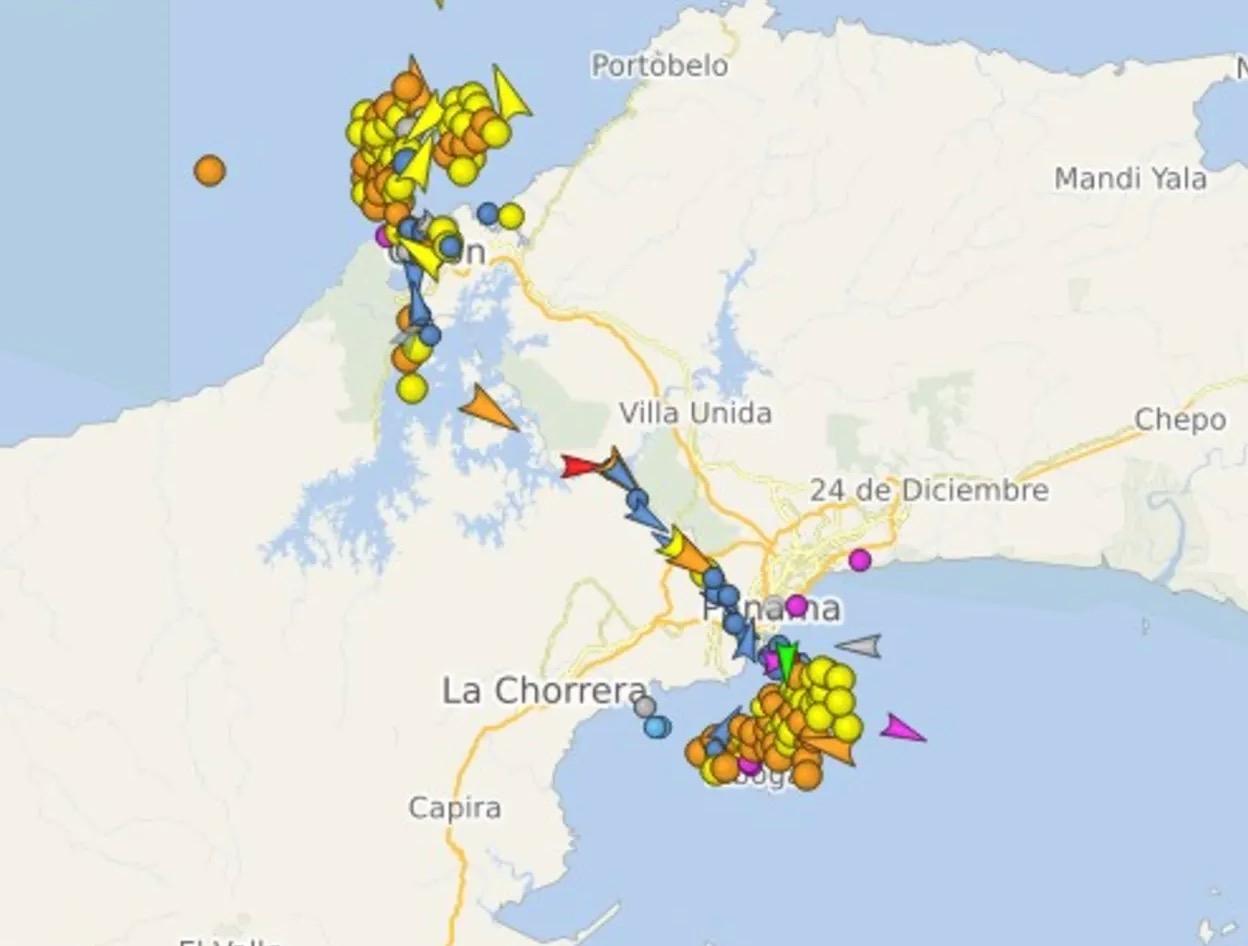
Where is Supply Chain Risk? 60% of Fuel, Food, and Cargo Travels Via Sea and Squeezes Through These Eight Chokepoints
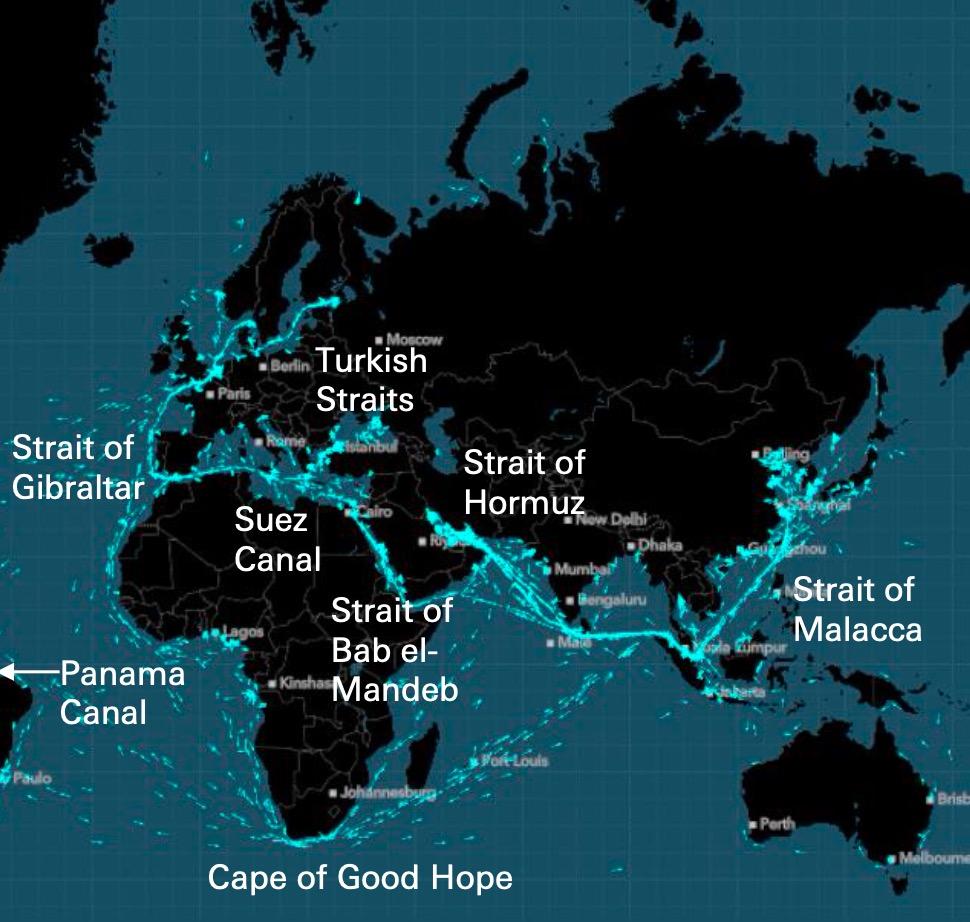

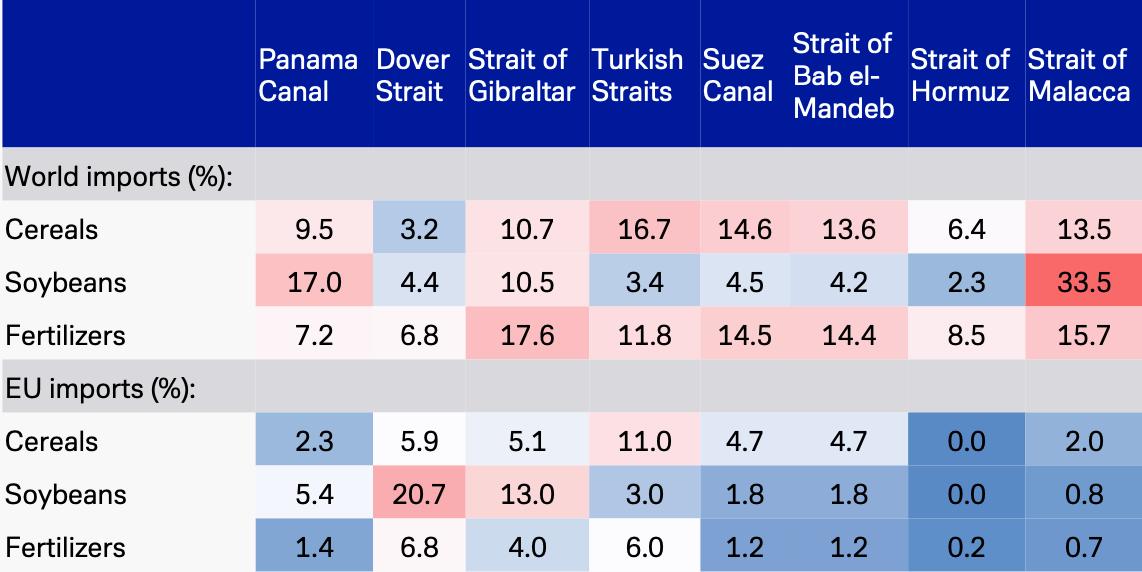
Source: Deutsche Bank Research; Bloomberg, US Government Sources
The Ukraine War is Becoming the Endless War
• While Ukraine’s recent counteroffensive was incrementally successful, it did not result in an outright military defeat of Russia. Winter is here and Russia is now beginning to push back.
• Moscow’s strategy is now clear: A long war of attrition. The war is likely to grind on for as long as four or more years (US Defense officials have consistently counseled US defense manufacturers to anticipate the war to continue for as little as two more years and as long as five years).
• Ukraine has an advantage of morale, quality of equipment, and operational/tactical capability. But they have suffered horrific losses of men. Russian forces are exhausted, ill-equipped, poorly trained, and demoralized. But Russia has an advantage of manpower and has begun mitigating logistical and production constraints.
• What do the US and EU do going forward? Growing resistance to endless military and financial aid is growing. Will the West tap out before Ukraine?


The BRICS Expand: Not An Immediate Threat to Dollar Dominance

• The BRICS (Brazil, Russia, India, China, and South Africa) at their annual meeting in Johannesburg in late August invited Iran, the UAE, Egypt, Ethiopia, and Saudi Arabia to join the bloc. Argentina rejected the invitation.
• Many of these developing economies want access to the BRICS-run New Development Bank for financing (allowing them to escape World Bank and IMF restrictions as well as Western sanctions. Egypt, Ethiopia, and Iran rank among the top 20 for worst annual inflation.
• But the growth of the BRICS needs to be watched closely: With this expansion effort, six of the world’s nine-biggest oil producers will become members as of January 1, 2024. Russia is the world’s #1 wheat exporter (#4 producer). China is the #1 wheat producer and India is the #3 wheat producer and #1 rice exporter.
• Both China and Russia want more expansion for both geopolitical and geoeconomics reasons. They see expansion as a means to breaking U.S. Dollar dominance and to get around U.S. and other Western sanctions and tariffs.
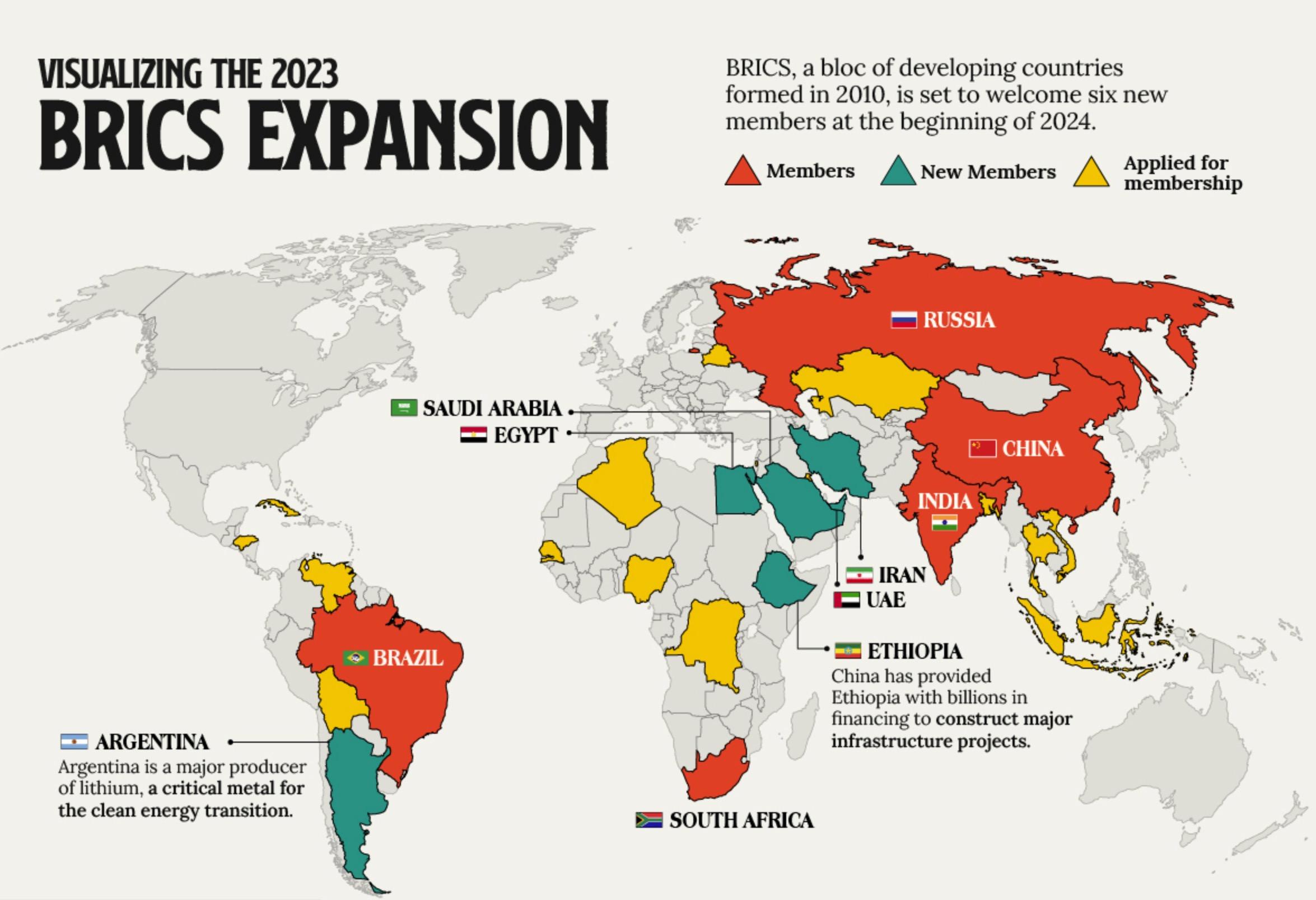
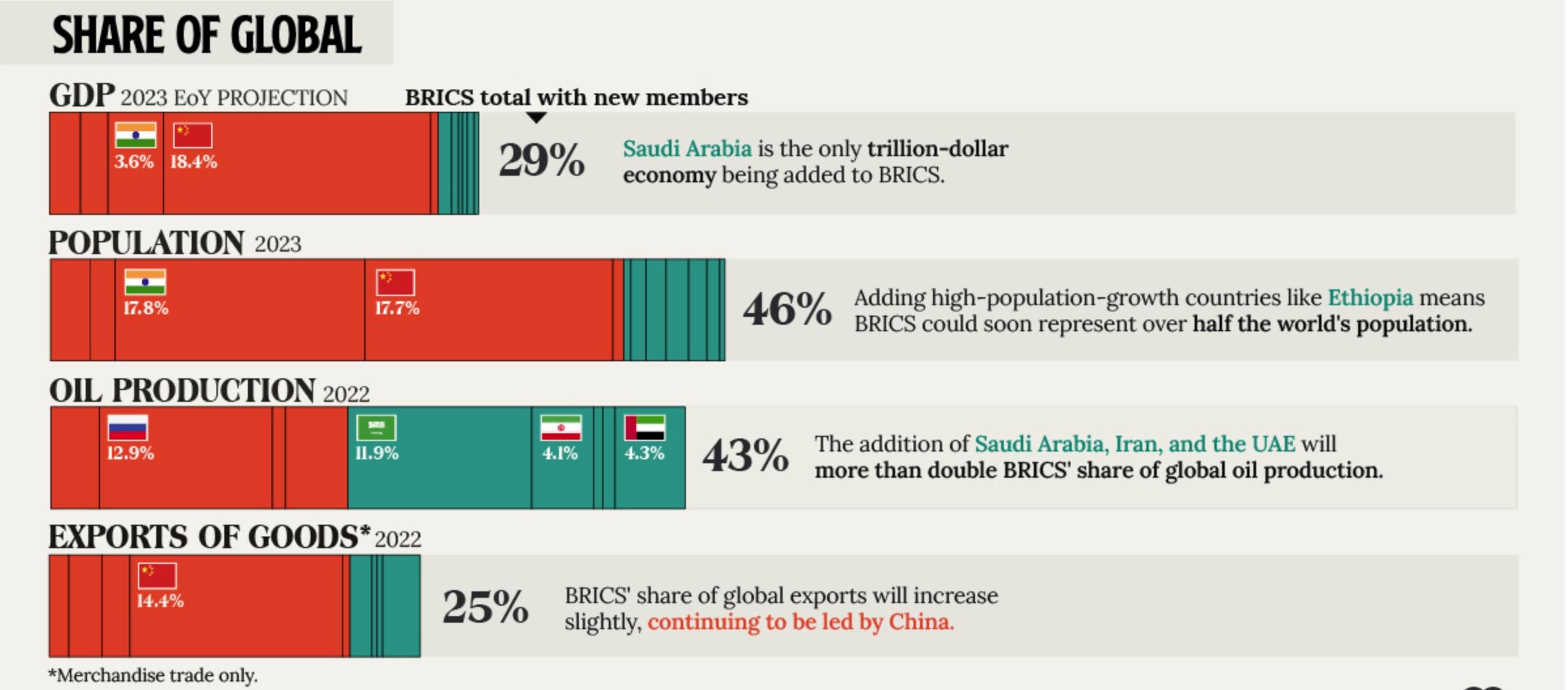
14
Source: IMF, Visual Capitalist, WTOOther Geopolitical Risks: Here is the Laundry List
FoodSecurity Crisis
• North Korea – Increasingly desperate in the wake of COVID which killed an estimated 2 million people (out of a population of 25 million). Missile test launches are usually a precursor to demands for aid. Also, North Korea is now a major producer of Russian ammunition – which means, they are exporting weapons they would need to threaten the South (minimizing any war threat).
• Crisis-Induced Mass Migration – If food security issues worsen (the dissolution of the Black Sea Grain Initiative, famines in Africa and Middle East), experts worry we will see new waves of mass-migration into Europe. We are already seeing the impact in recent European elections.
• Emerging Market Debt – There are numerous emerging market countries deeply indebted to China as part of the Belt & Road Initiative (e.g., Sri Lanka, Ghana, Pakistan, etc.) and face defaulting on payment (China has spent more than $250 billion in 2023 already in bail-outs).
• Russian Asymmetrical Warfare - Underwater communications sabotage, satellite sabotage, denigrating/damaging the Ukrainian electrical grid or even Europe’s grids, tactical nuclear or chemical or biological attacks in Ukraine (doubtful/unlikely) cyber attacks, Sabotage of global food supply channels, social media manipulation and use of AI-created “Deep Fakes.”

Sources: the Guardian; Reuters; American Economic Association; Office of the Director of National Intelligence

What is Washington Going to Do Between now and the 2024 Elections?
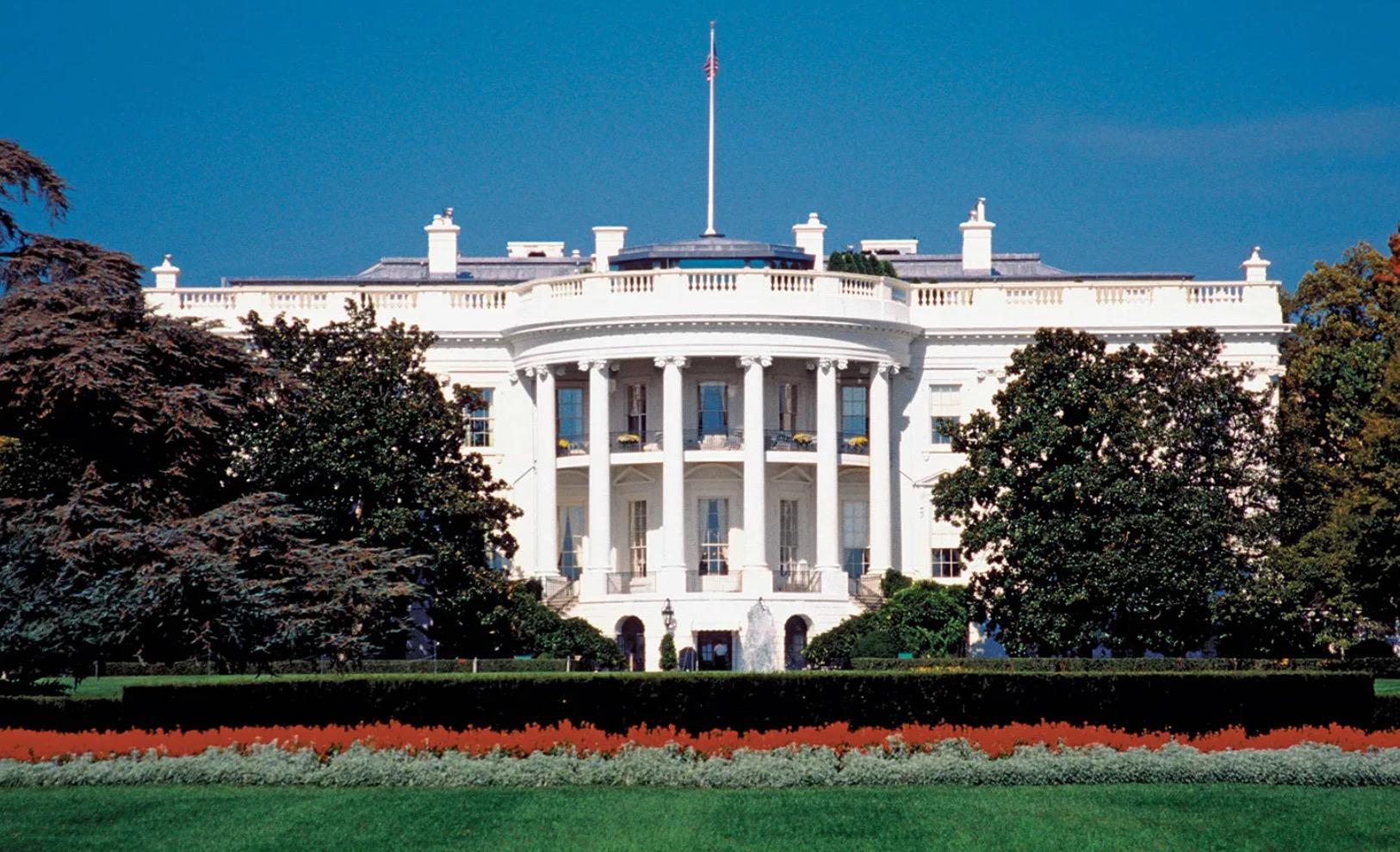
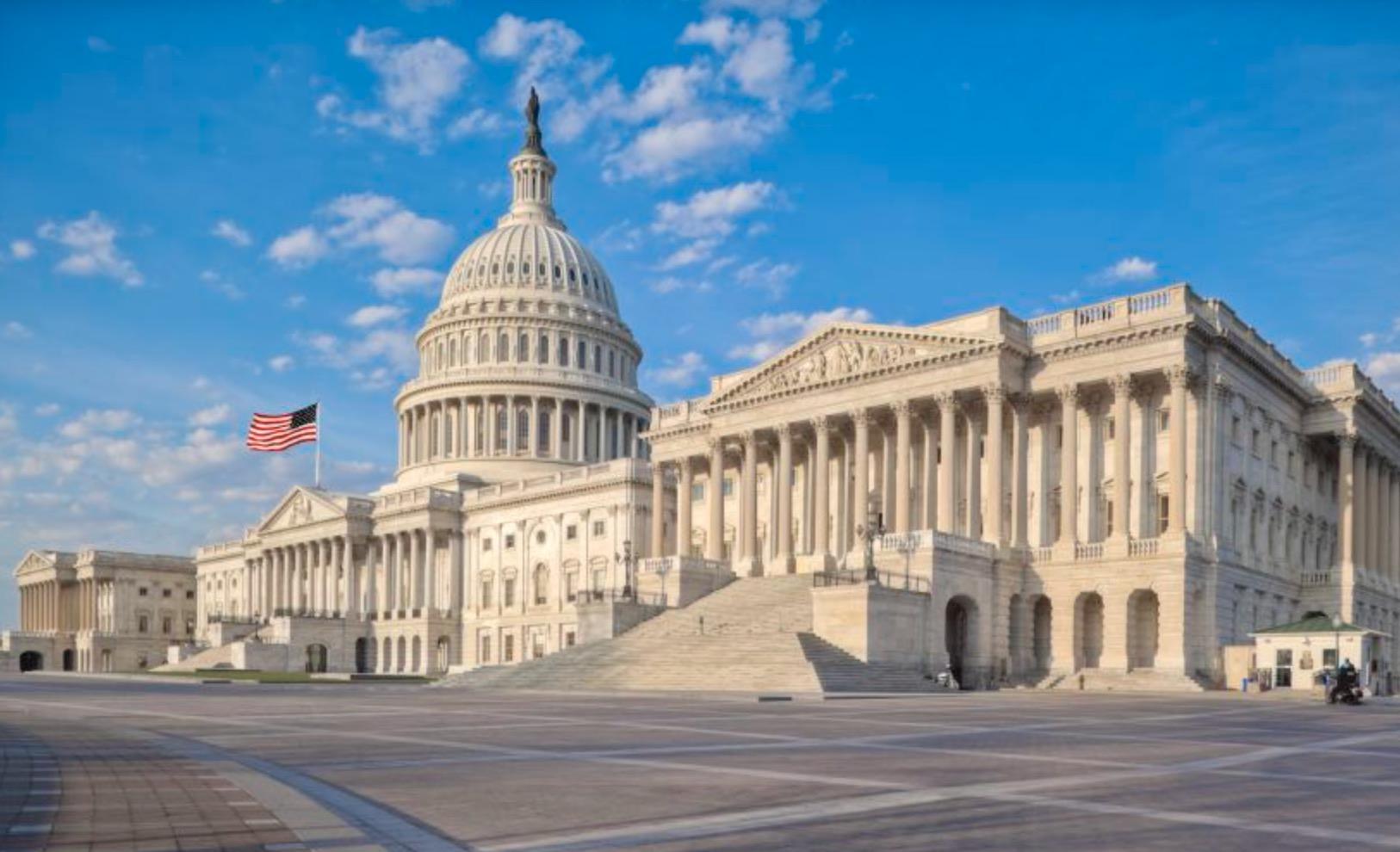

To the Question of What Else Congress Will Do Before the Election…
Not much.
• Now that the government funding bills are finally done, the one big thing left on the table is funding for Ukraine, Israel, and Taiwan and the farm bill.

• But there are few other big items that might get done this year.
• And much of the rest of the year will be spent positioning issues to be dealt with in 2025 – 2026… All of which will have big impacts on us.

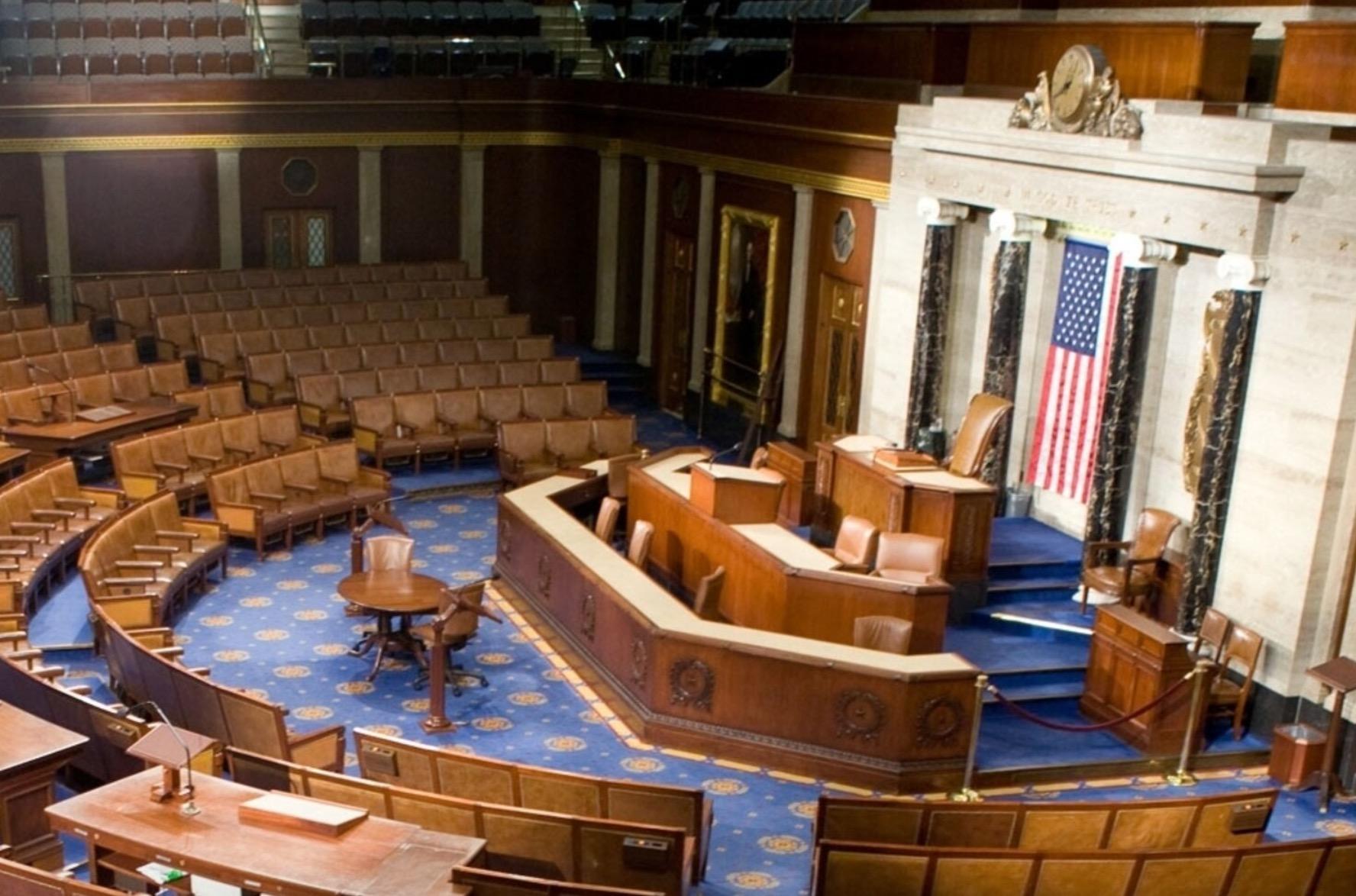
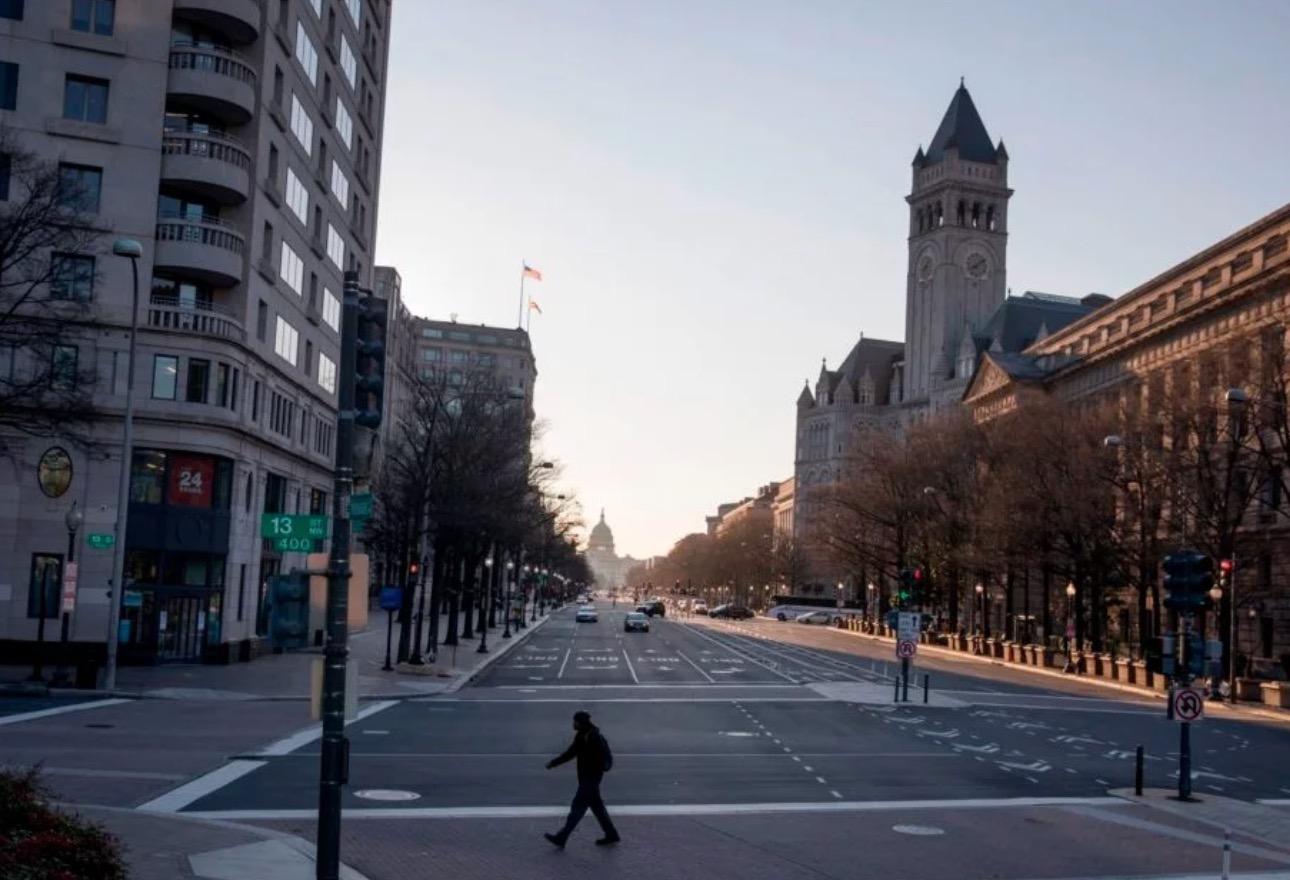
Laying the Groundwork for More US Industrial Policy?
• The Biden Administration has been a structural shift in US domestic economic policy – commonly referred to by President Biden as “Bidenomics.” Onshoring/nearshoring/friendshoring are the most common components of this policy.
• Biden and his team believe the US industrial base has been “hollowed out” and needs strong US government support and funding to build it back up.
• There are three pillars to Bidenomics:
Ø The quality of economic growth matters more than the quantity.
Ø Laissez-faire economics (embraced by Republicans and most moderate Democrats) does not work. Why? Because it does not factor in issues like climate change, fragile supply chains, or geopolitical vulnerabilities. Thus, private capital must be directed toward favored sectors via regulation, subsidies, and government intervention.
Ø Trade policy should give priority to American workers – not consumers.
• US foreign policy must not only incorporate but also champion a range of economic issues: workers rights, climate, tax.
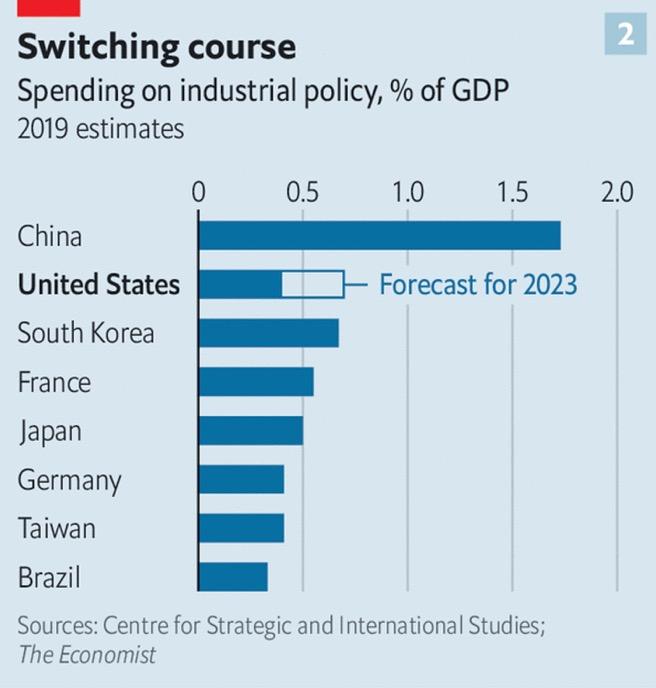

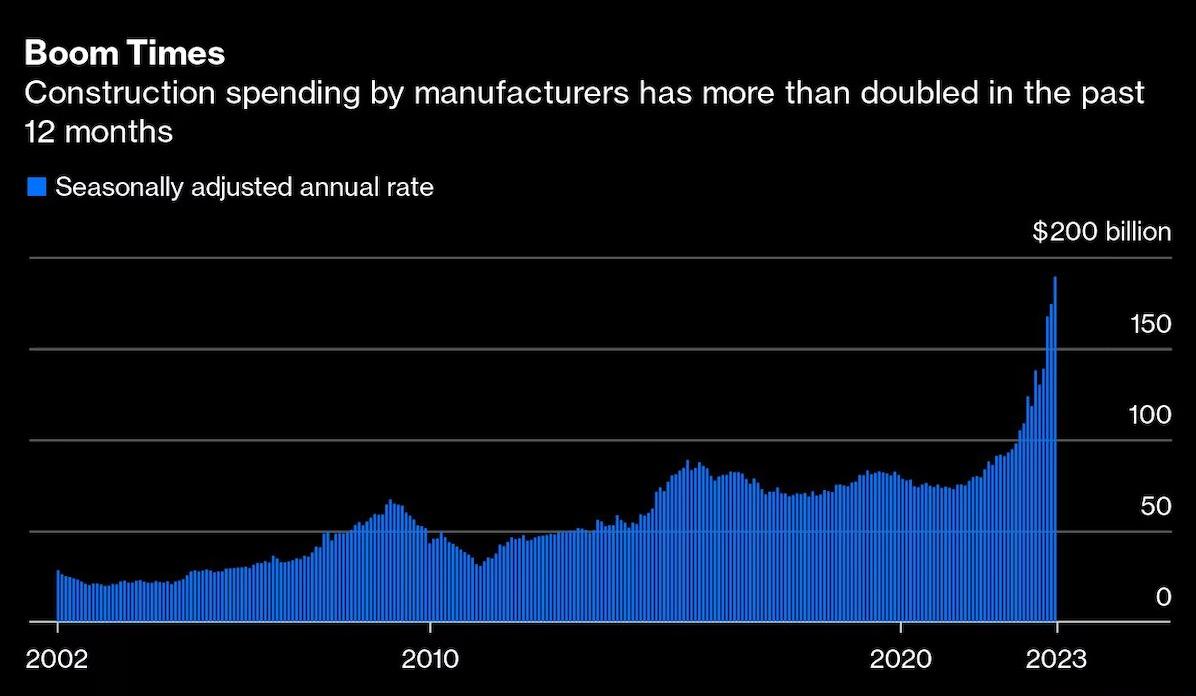
Case Study: The Drive for US Chip Supremacy
• Semiconductor production in the US is the one area where bipartisanship presides in Washington all in the name of “national economic security.”
• The Biden Administration and Congress took up this challenge in 2022 by passing the CHIPS Act which grants close to $100 billion in federal funding on building up the chip industry. Two examples:
Ø Intel broke ground on a new $20 billion facility in Columbus, Ohio.
Ø Micron broke ground on a $15 billion expansion in Boise, Idaho and announced a new $100 billion buildout over 20 years in New York – the largest in the world.
• Combine this with the $550 billion funding from the Infrastructure bill also passed in 2022, and it is a potential boon for numerous sectors, particularly for commercial real estate, residential real estate, etc.
• Who else qualifies under CHIPS? The Pharma industry

Which other states have gotten CHIPs Funding?
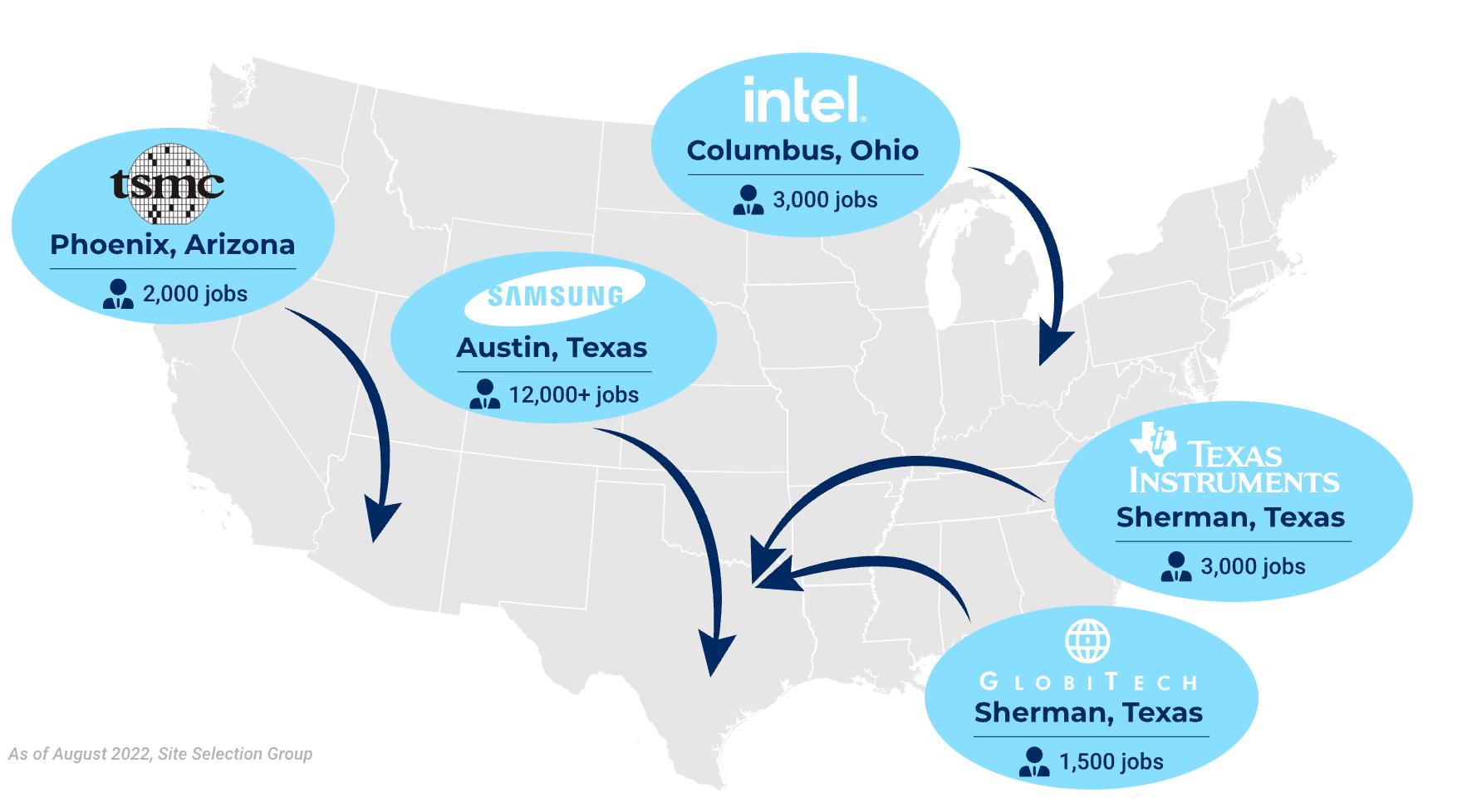
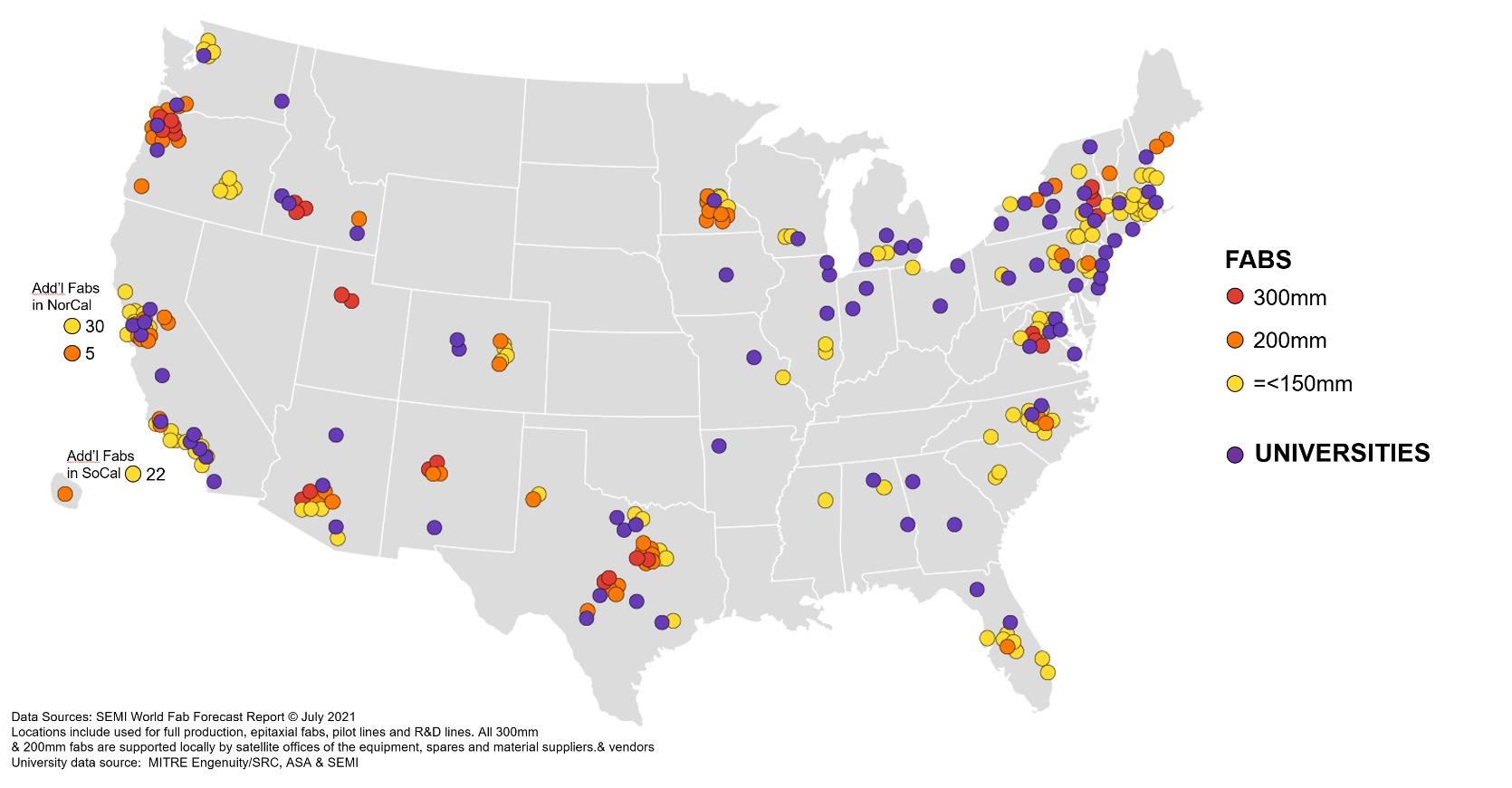
• What are the chances of CHIPS 2.0?
Source: Semiconductor Industry Association
Tax Reform for the Next Two Years Won’t Happen.
But Watch for the Groundwork Being Laid in 2024 for 2025

• We see little to no chance of any major tax legislation at the federal level for the next two year as there is little room for agreement on any reforms of corporate or individual tax policy in 2023-2024.
• However, many Trump tax provisions expire at the end of 2025. What will happen between now and then in preparation of the next Washington Tax War?
• What we do expect to see is the various tax advocacy groups laying the predicate for tax reform after the 2024 elections. Washington will be awash in white papers, think tank events, and plenty of Congressional hearings –even a fair share of legislative proposals. What will be the focus? Among the issues we have heard discussed:
Congressional Oversight Hearings Ahead… Lots
and Lots of Hearings

Some of the hearings we understand are coming in the next few months:
Ø Two years after President Biden vowed to spend $7.5 billion (via the Bipartisan Infrastructure Law) to 500,000 charging stations by 2030, a grand total of seven stations offering 38 spots to charge in four states have been built (so far, only in New York, Hawaii, Ohio, Pennsylvania). Why and where has the money been spent?
Ø America’s Electrical Grid: National security concerns, demand concerns, regulatory overkill.
Ø The Strategic Petroleum Reserve (SPR): Where are we in refilling it and when will it get done?
Ø Emissions Standards and How Will the US possibly meet the the Biden Administration’s 2032 EV requirements (where 68 percent of cars on the run must be EVs).
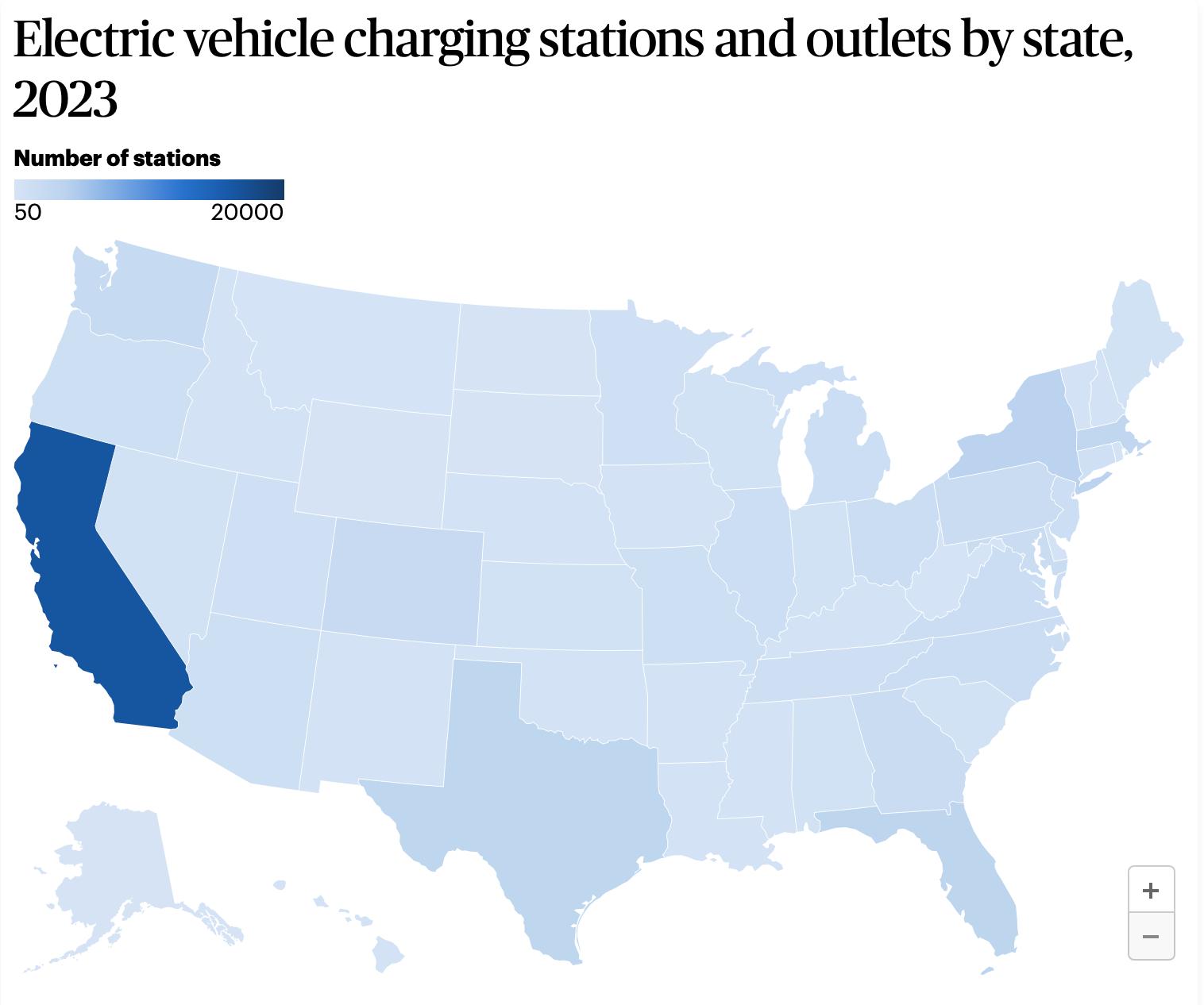
Sources: US Department of Energy, Washington Post, CNBC 21
The Supreme Court and US Regulators: Time to Regulate the Regulators?

• One thing you can always count on in an election year in Washington: As Congress increasingly grinds to a halt in passing legislation, regulators ramp up their regulatory work stream.
• This is one reason so many proposals from the FERC, EPA, SEC, CFTC, Federal Reserve, FHA, etc. have not been completed yet – lots of “study” and waiting until Congress hits election year gridlock.

• The Supreme Court recently heard a very big case challenging the role of all federal regulators and their reliance/use of in-house administrative courts. Specifically, this case goes to the constitutionally of the CFPB’s funding structure as well as the SEC’s in-house enforcement regime.

• But what does this mean for regulated industries? In short, if the Court rules against the regulators in this case, declaring them unconstitutional, then it will be very hard not to say a lot of what the agencies have done in years past is illegal. And this would be applicable to ALL Federal regulatory agencies.
• In the interim: Expect the regulators to race to push out as much as they can before the ruling is handed down later this spring.
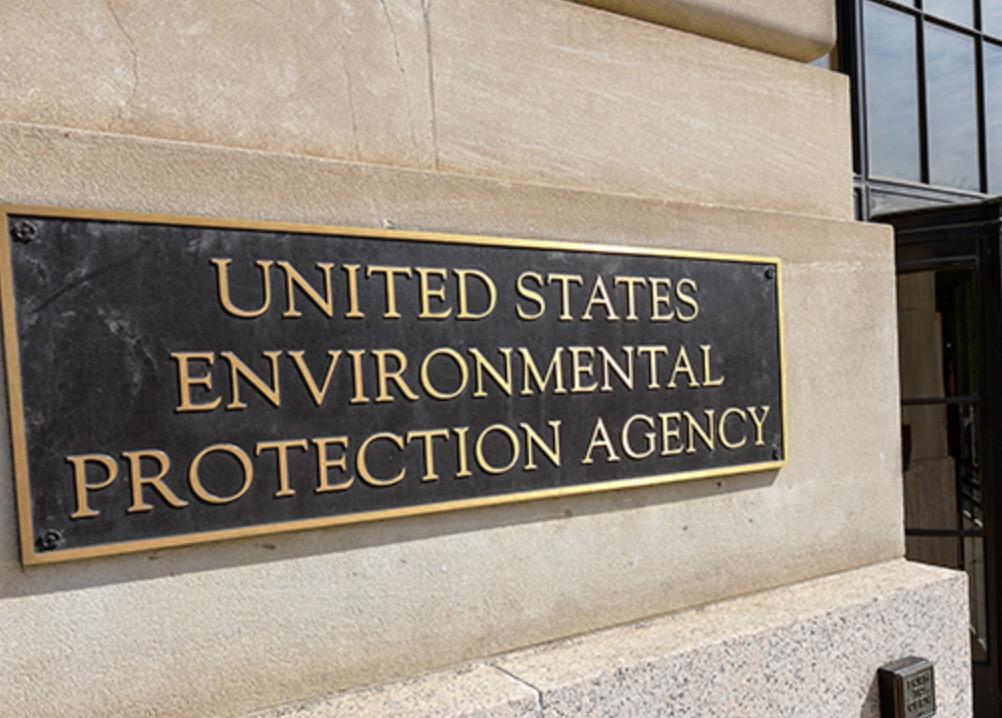
A Crisis of Fulsome Economic Data? Is Washington Flying Blind?

We have seen a significant increase among voters calling into question the validity of economic data coming out of Washington. And they are not wrong. Participation in government economic surveys are in many cases massively down. This raises significant questions: How much does this skew numbers overall? What if the people who do not respond to the surveys are much different from those who do respond? How do you get businesses to respond to make survey results more robust and ensure credibility is restored to government data releases?

Source: Labor Department; Wall Street Journal 23

US Elections, Policy, & Markets
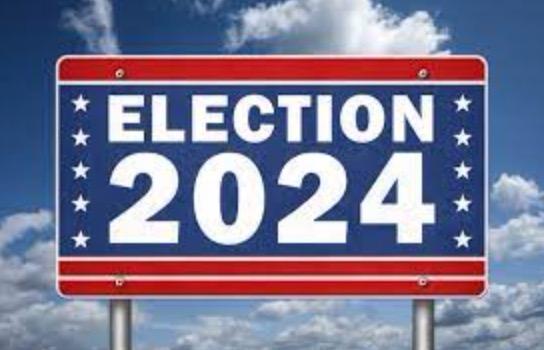
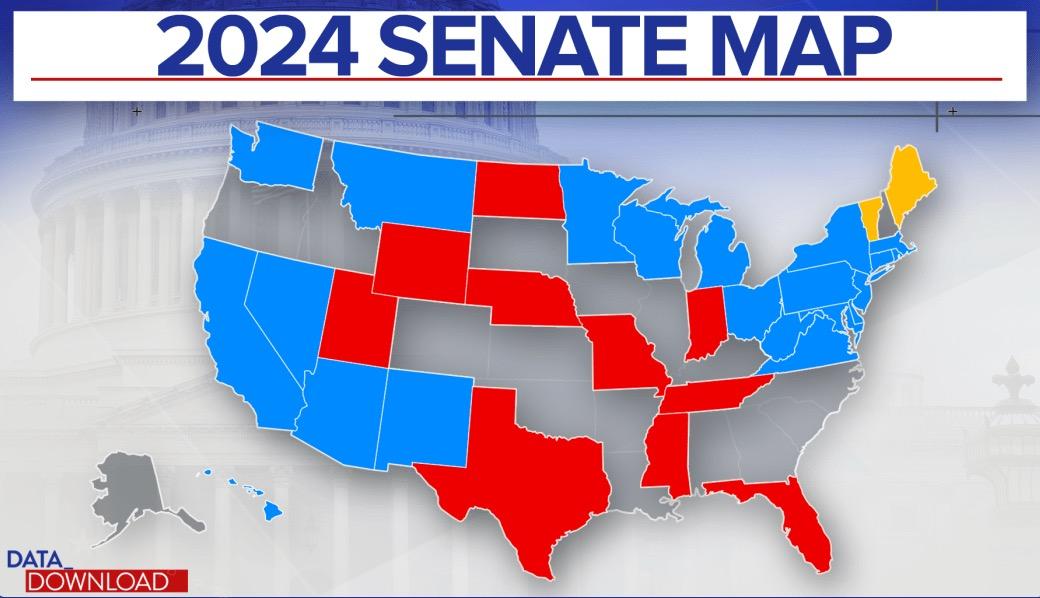

The 2024 Choice: Biden or Trump or a Third -Party or Independent Candidates.




Could a 3rd Party Candidate Swing the Presidential Election?
• A third-party candidate has never come close to winning even one elector in previous elections.
• With polls showing a tight race between President Biden and former President Trump, third-party candidates are poised once again to impact the outcome of the election.
• Washington, D.C.-based nonprofit No Labels is currently gathering signatures across several states to qualify as an independent party in the 2024 presidential election. So far, No Labels has gained access to the ballot in 13 states, including swing states Arizona, Nevada, and North Carolina.
• Jill Stein has been confirmed for the ballot in 27 states and the District of Columbia, and is awaiting confirmation in more than a half-dozen others.
Notably, the Green Party has obtained ballot access in three swing states: North Carolina, Michigan, and Wisconsin. The party also has pending litigation in Georgia.
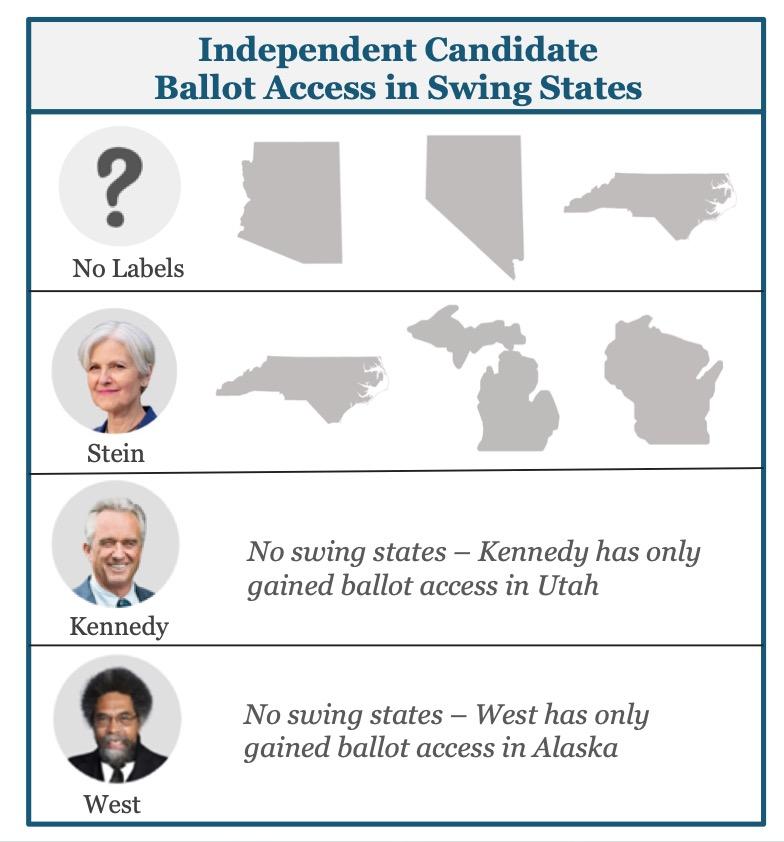

What Happens if There is a Sudden Vacancy in the Presidential Election?

What would happen in a major-party candidate died or abruptly dropped out of the presidential race before election day?
The age and health of presidential candidates has become a hot topic for voters, as many Americans express concern about the advanced age of both the Republican and Democratic frontrunner for president. If either Biden or Trump drops out of the race at any point this year, it would have massive, unprecedented implications for the affected party.
Ø From now until March, if Trump were to withdraw, the Republican party would have well-funded, formidable alternatives. Conversely, if Biden were to withdraw, Democrats would scramble to appoint a candidate with broad support.
Ø If a candidate were to drop out after primary season, it would be nearly mathematically impossible for an alternate candidate to win the nomination, as by mid-March both parties will have allocated a majority of their delegates. In this scenario, anyone running would seek out uncommitted delegates to pledge their support. The last time a major party needed more than one ballot to nominate a presidential candidate was in 1952.
Ø Notably, the presidential and vice presidential ballots are separate at the Democratic convention, so Biden’s delegates would not automatically transfer to VP Harris.
Concern Among Democratic Voters Over Biden’s Health: Who is in the Bullpen?
The chatter in Washington among Democrats (and Republicans) is high as to who is likely to step up if Biden steps back. But the White House is insistent: President Biden is “all in.”

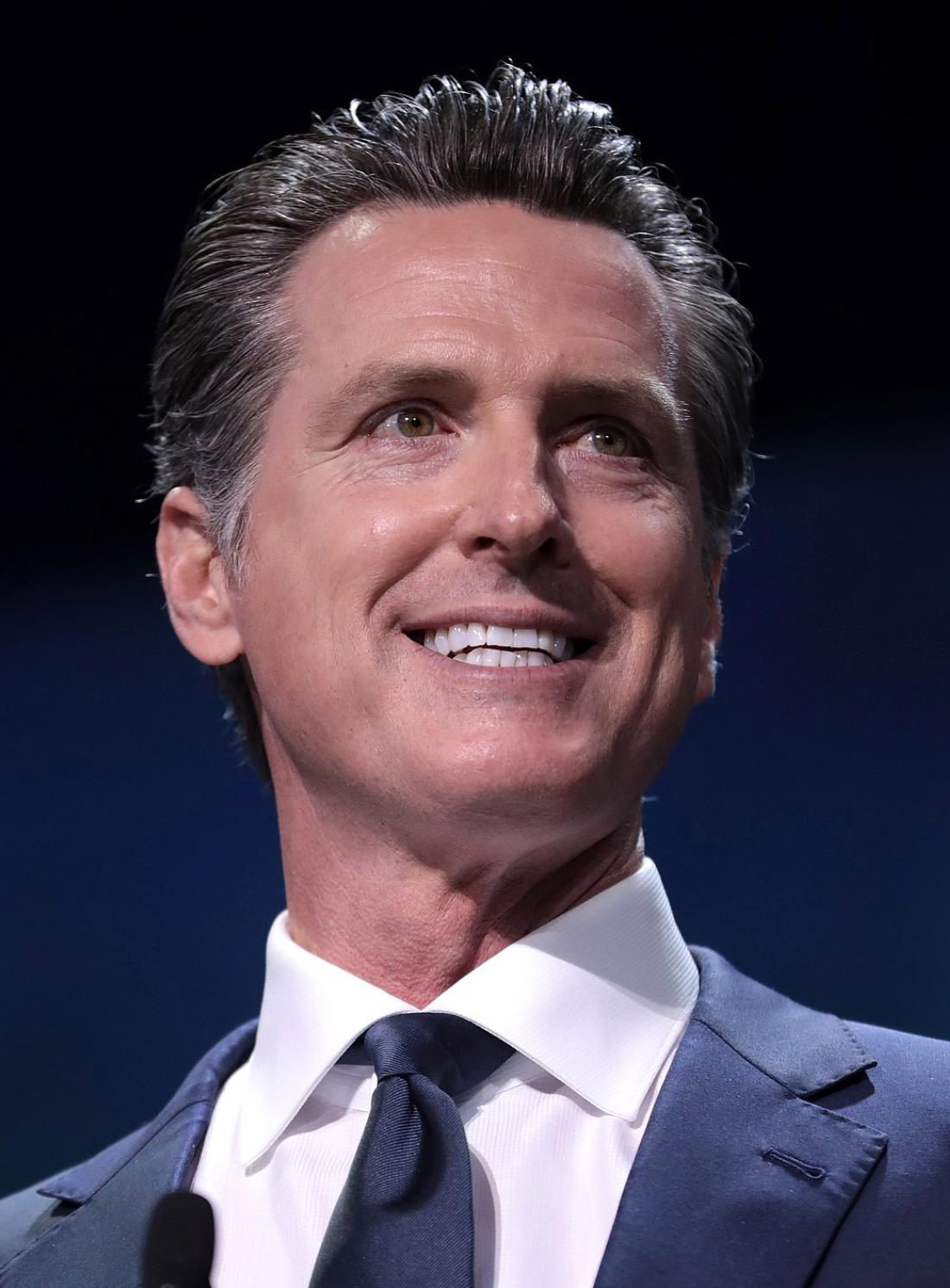
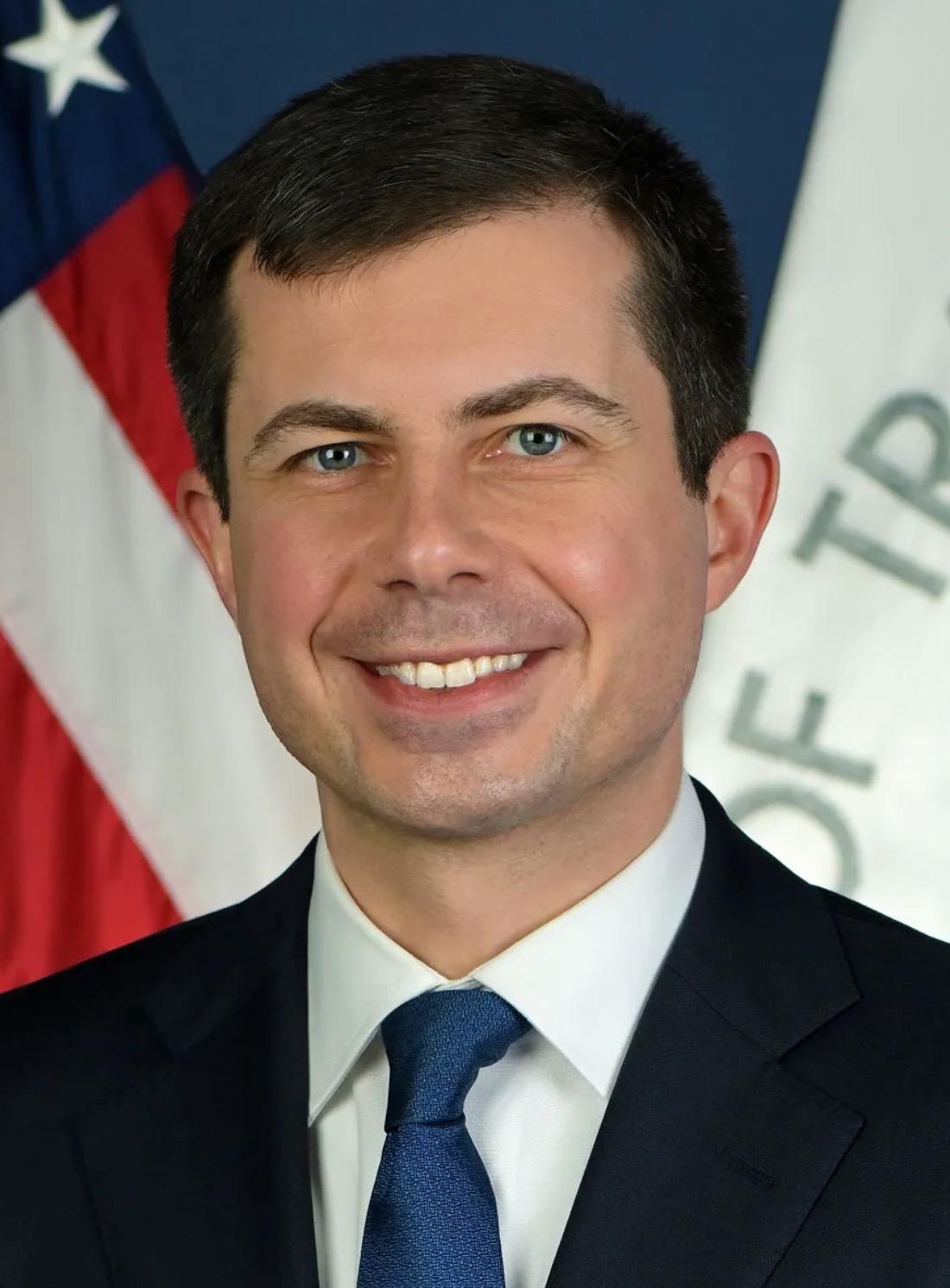
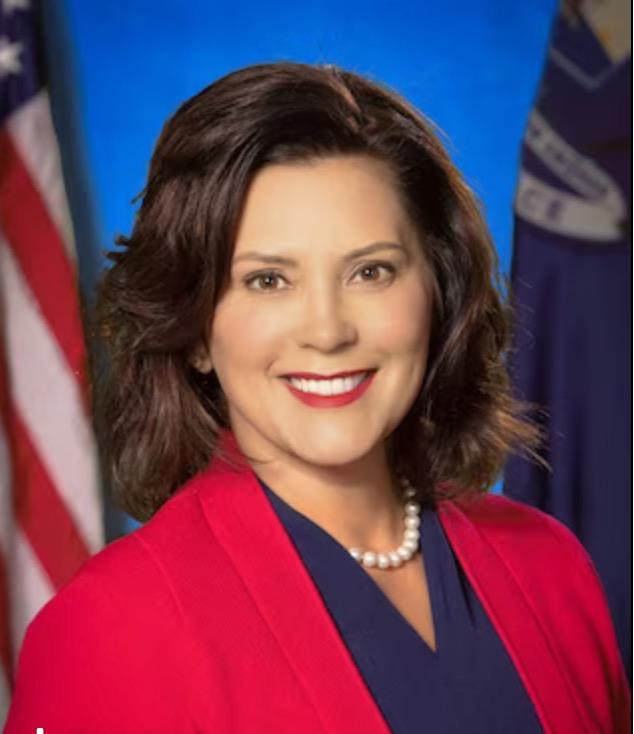

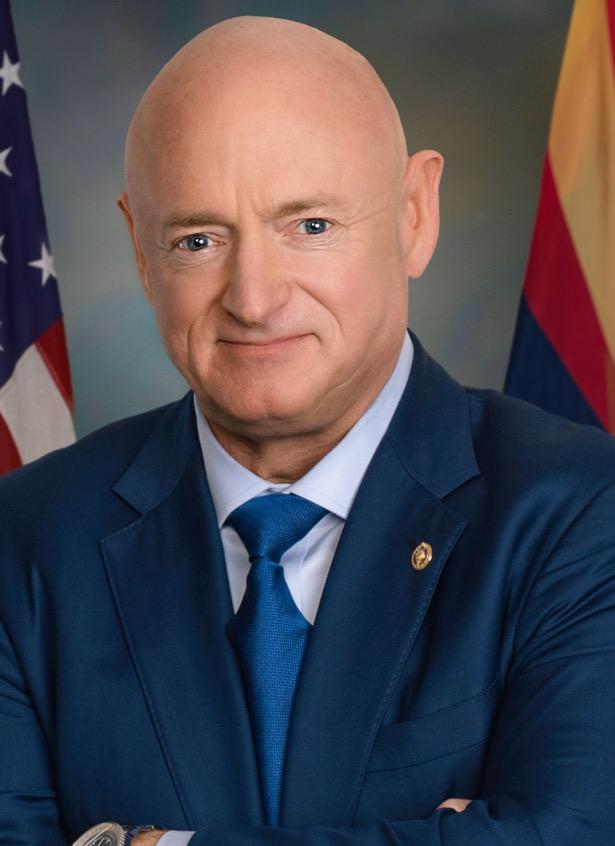
What Does the Electoral College Projections Look Like Today: The 77
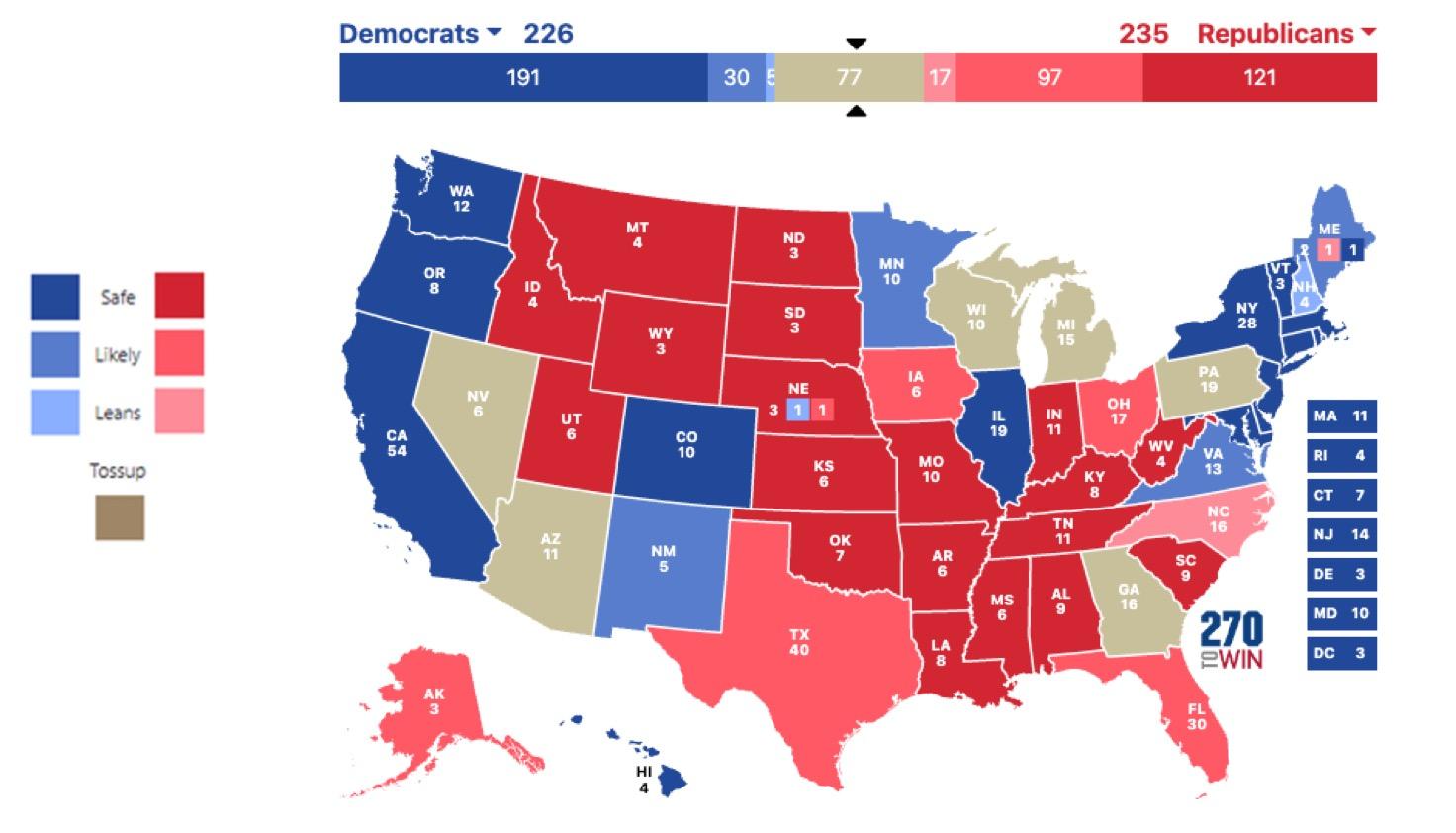

The
2024
Presidential Elections are Likely to Come Down to Who Wins These States

Arizona Biden Trump Georgia Biden Trump Michigan Biden Clinton
Nevada Biden Clinton
Pennsylvania Biden Trump
Wisconsin Biden Trump
Source: New York Times; CNN
Who is Winning These Battleground States Now?
Battleground State Polling (as of 4.1.24)
Arizona Trump +5.2

Georgia Trump +5.2
Michigan Trump +3.5
Nevada Trump +3.0
Pennsylvania Trump +0.2
Wisconsin Trump +0.8
Source: Realclearpolling as of April 1, 2024 31
If You Think You Are Seeing A Lot More Political Ads this Election Cycle Than Ever Before, You Wouldn’t Be Wrong…
• Political spending on advertisement on this election cycle is expected to surpass $10 billion – a 13% increase over 2020.
• How much was spent in 2016? $2.6 billion.
• Breaking it down, estimates are:
Ø presidential campaigns will spend in excess of $2.7 billion (individual and outside groups combined)
Ø Senate campaigns will spend in excess of $2.1 billion
Ø House campaigns will spend in excess of $1.7 billion
Ø Gubernatorial campaigns will spend in excess of $361 million
Ø And more than $3.3 billion will be spent on all the other elections (various statewide offices, state house and senate races, city councils, etc.
• Republican presidential candidates have already spent more than $100 million so far.

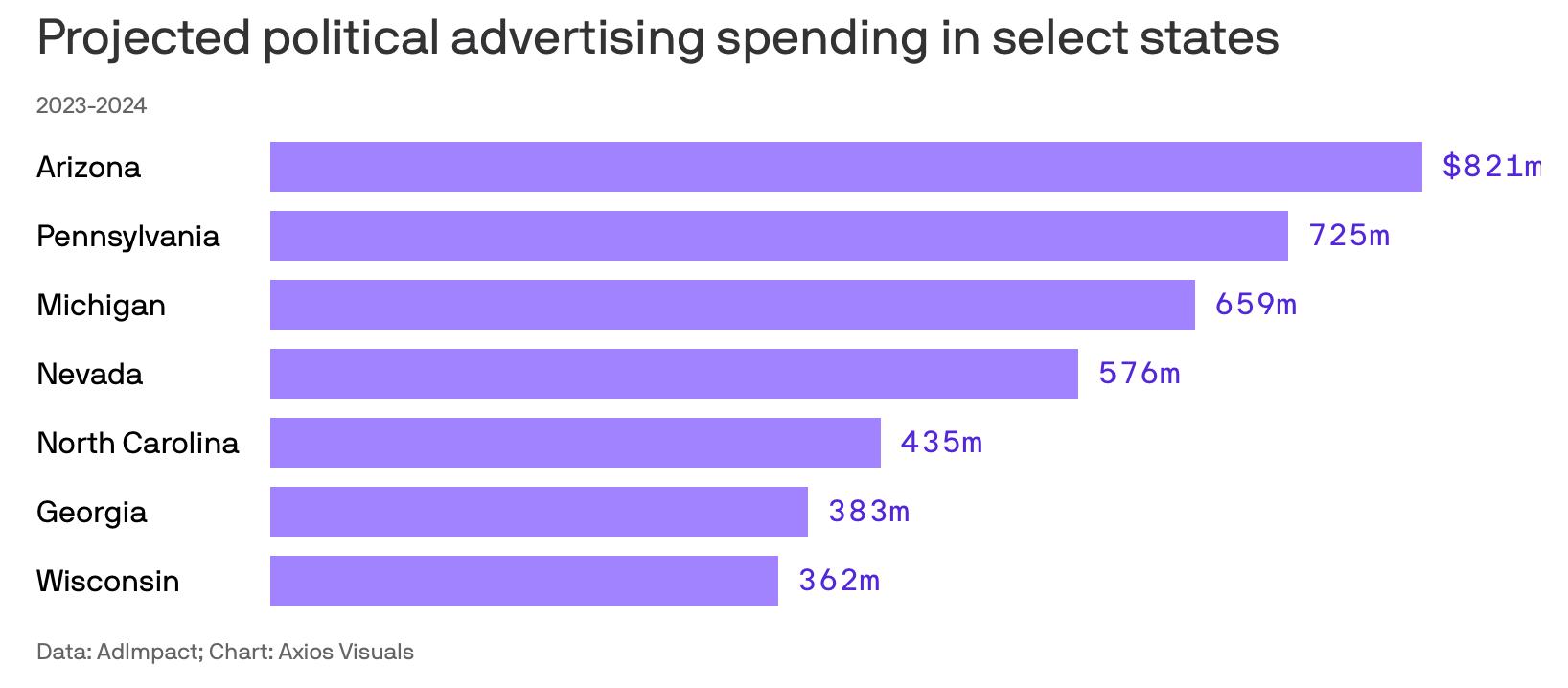
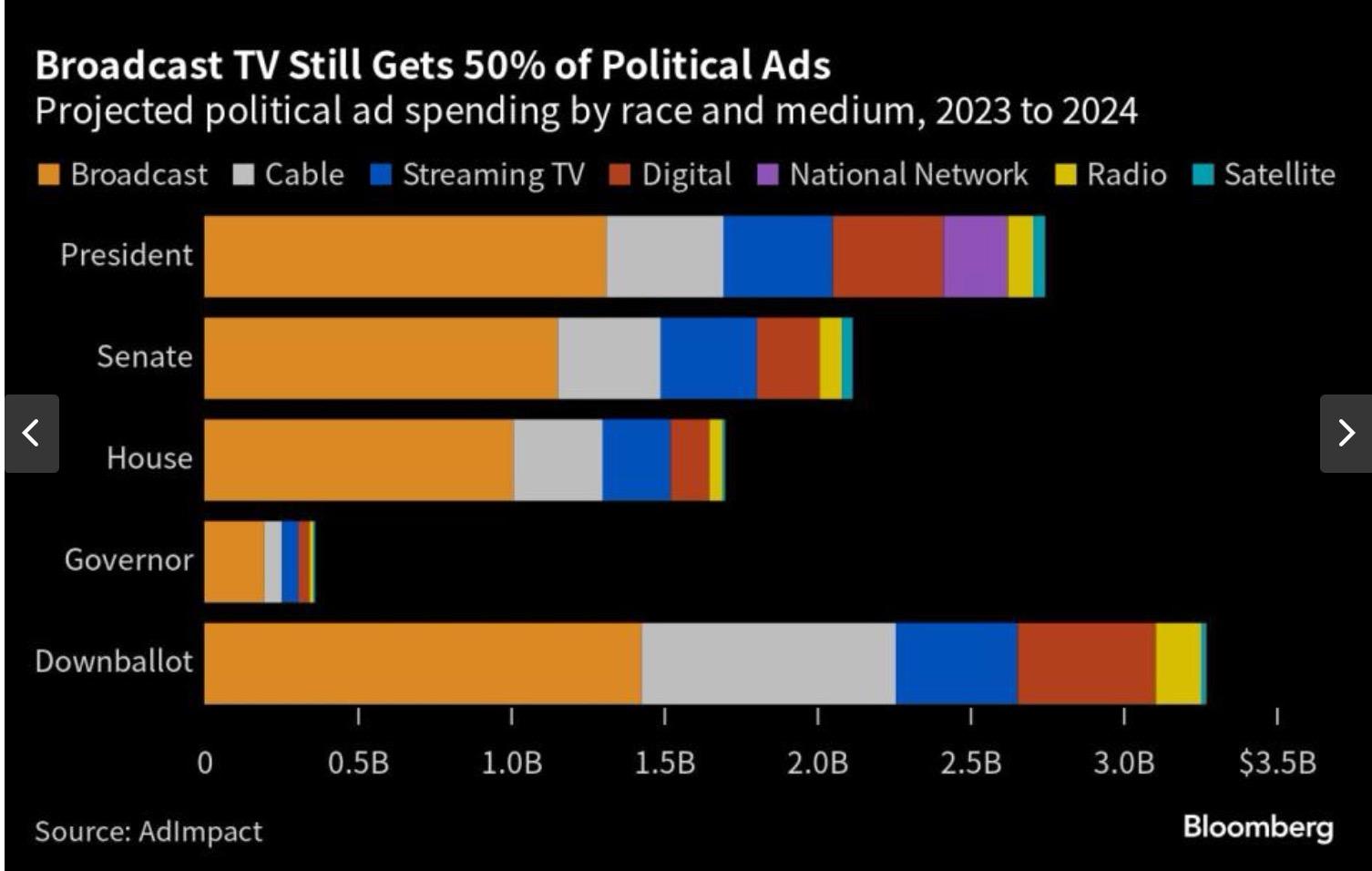
Sources: AdImpact, NBC News; Axios, Bloomberg
The Legal Challenges faced by Biden and Trump
We have never seen a situation like this in U.S. history where both leading candidates have considerable criminal legal challenges hanging over them.
President Biden
• Hunter Biden has been indicted on gun charges, tax evasion charges, and possibly drug charges.
• The House of Representatives are driving hard trying to get to the bottom of then Vice President Biden’s involvement and/or support of Hunter’s business dealings in Ukraine, China, and elsewhere.
• There is a good chance this ensnares other immediate members of the Biden family.
• Big Questions: Will impeachment proceedings really proceed? What are the odds of impeachment? And how much “there” is there?
President Trump
• The New York City Attorney has brought criminal charges against former President Trump.
• A US Special Counsel has brought criminal charges against the former President regarding his retention and handling of top- secret information.
• A Georgia County Prosecutor has brought criminal charges against the former President for election interference.
• The same US Special Counsel has brought criminal charges against the former President for his role in the January 6th event in the US Capitol.
• Big Question: Who will be testifying in the federal cases against the former President?

The 2024 US Senate Outlook: Can Democrats Hold Control?
Democrats must defend 23 of the 33 seats up in 2024, many in states that have become more Republican. Likely Republicans win control of the Senate.
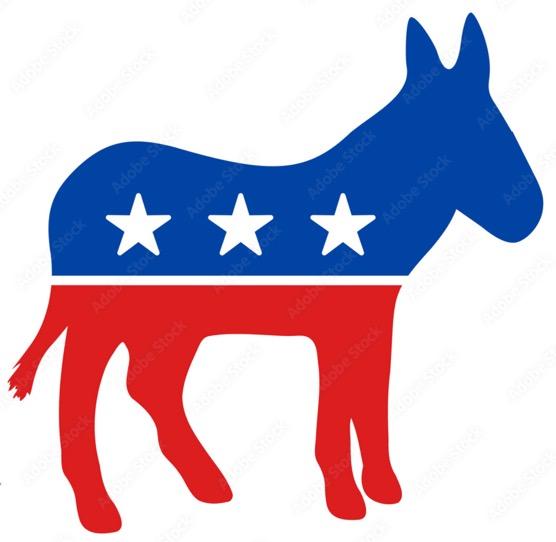
Democrats at Risk:
1. Sherrod Brown (D-OH)*
2. Jon Tester (D-MT)*
3. Joe Manchin (D-WV)*
4. Jackie Rosen (D-NV)
5.
6.
Republicans at Risk:
1. Open Seat (IN)
2.
3.
Independents at Risk:
Kyrsten Sinema (I-AZ) is not running again.

* = Trump won their states – Ohio, Montana, West Virginia – in 2016 and 2020
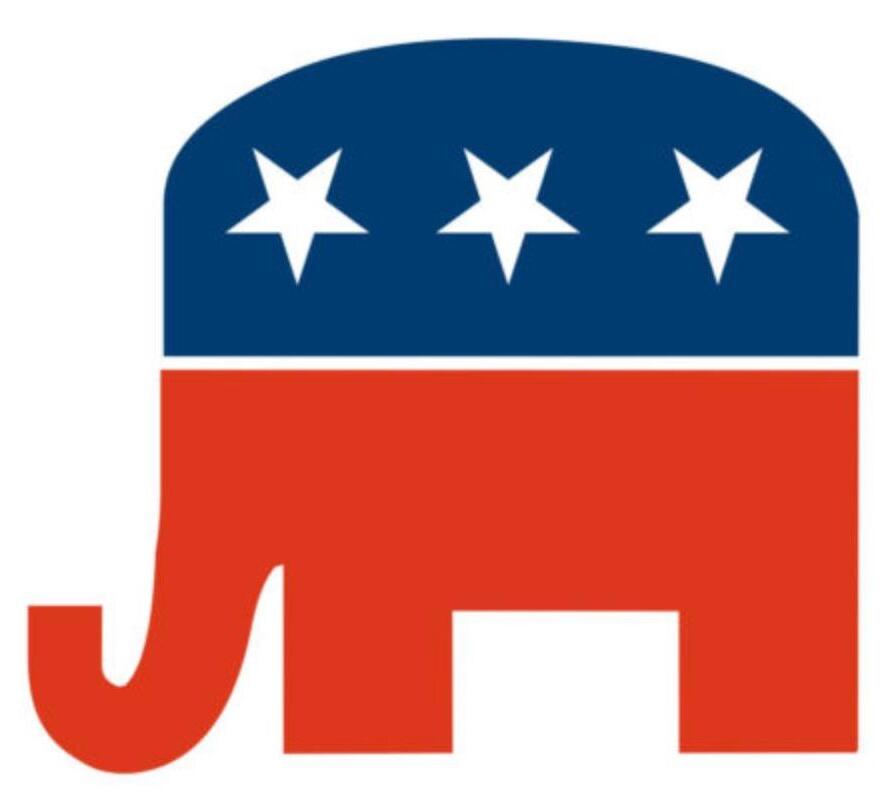
The US House of Representatives: Can Either Party Break Out with a Sizeable Majority?

Currently, there is a one-seat GOP majority in the House – with a loud GOP dissent faction – makes the current majority fragile. It was not much better than the last Congress for Democrats in the majority.
• Republicans have only a one-seat majority due five Republicans quitting in the last three months. Republicans are further weakened by the Caucus infighting which resulted in the ejection of Kevin McCarthy (R-CA) as Speaker of the House and election of Michael Johnson (RLA) as the new Speaker.
• But can Johnson survive? After getting the Appropriations bills passed, a new House Republican motion was put forward to force Johnson out.
• Redistricting in New York, North Carolina, Georgia, and Alabama is highly likely to result in five to eight Democratic pick-ups.
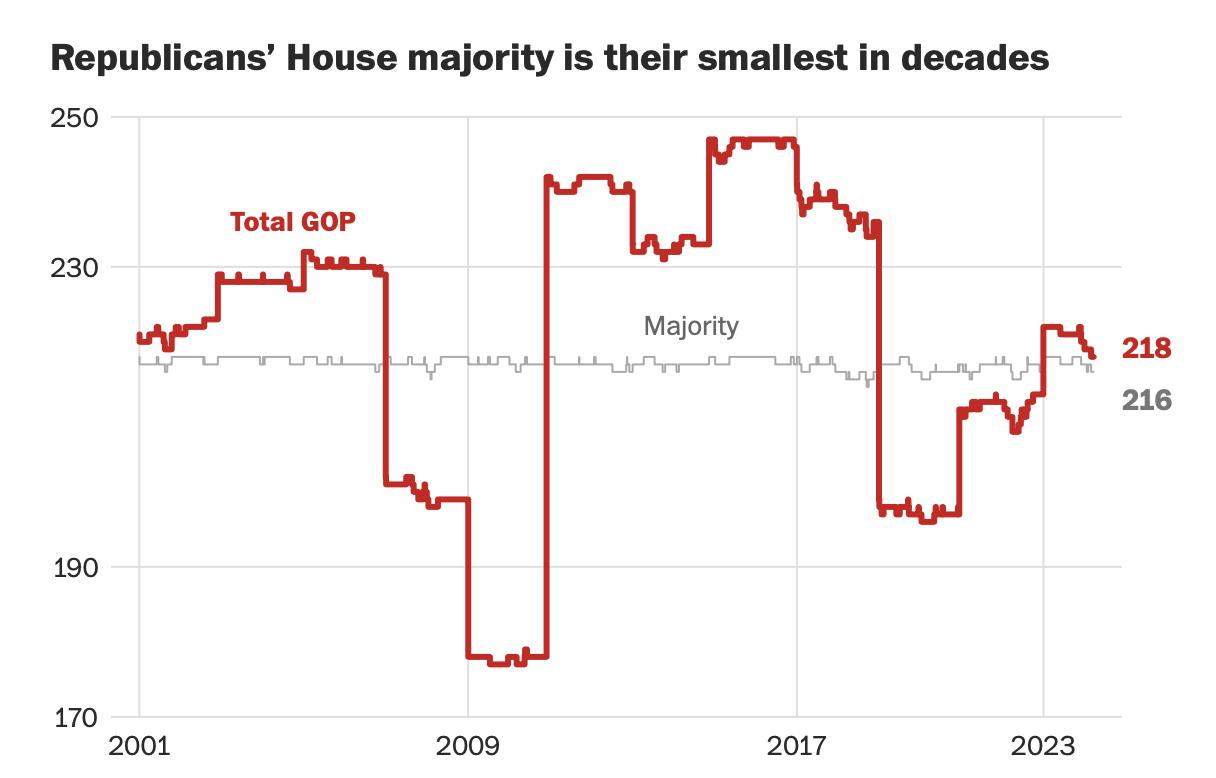
Source: Washington Post

Appendix: The US Electoral Calendar - What to Watch and When
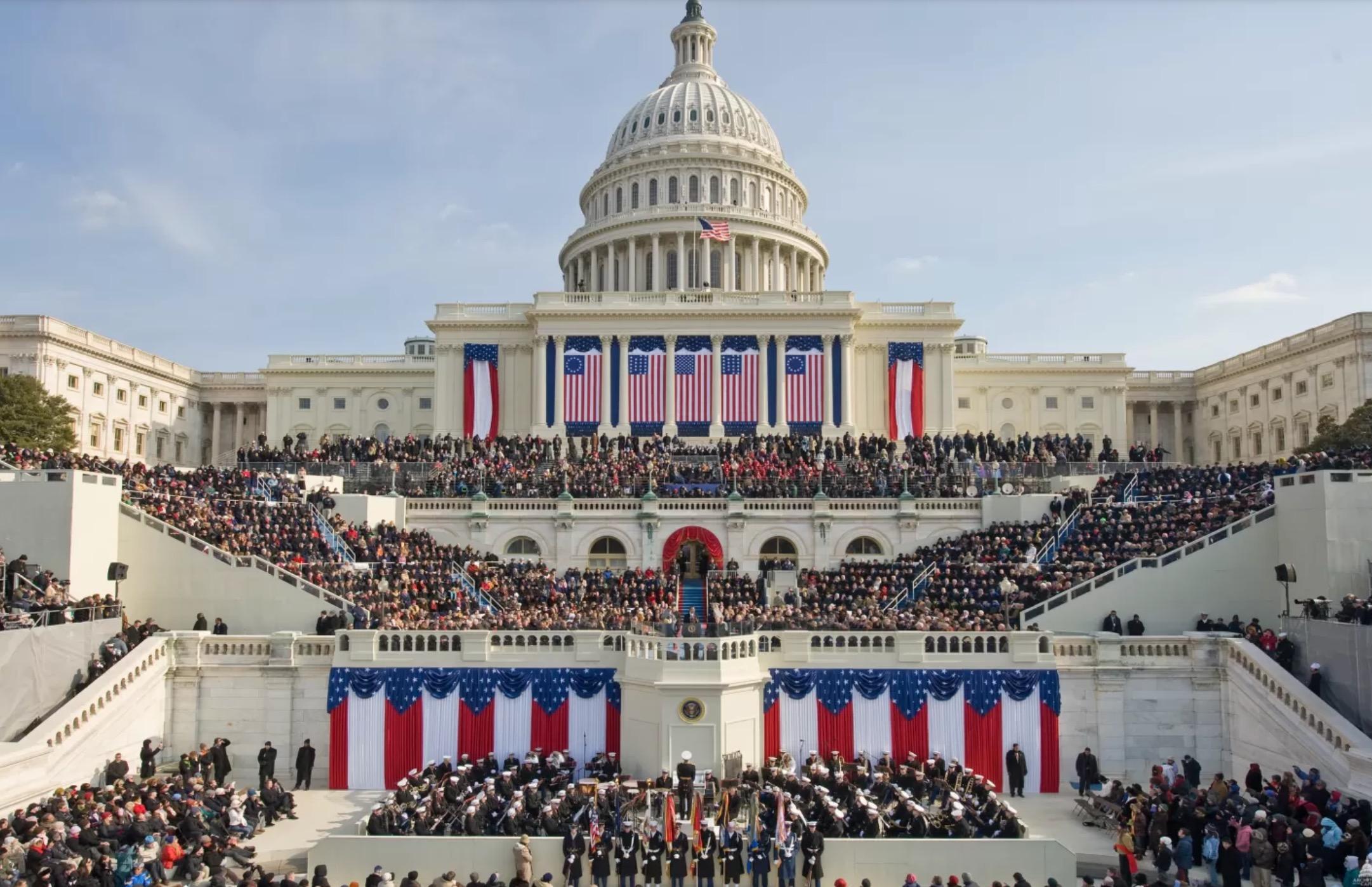
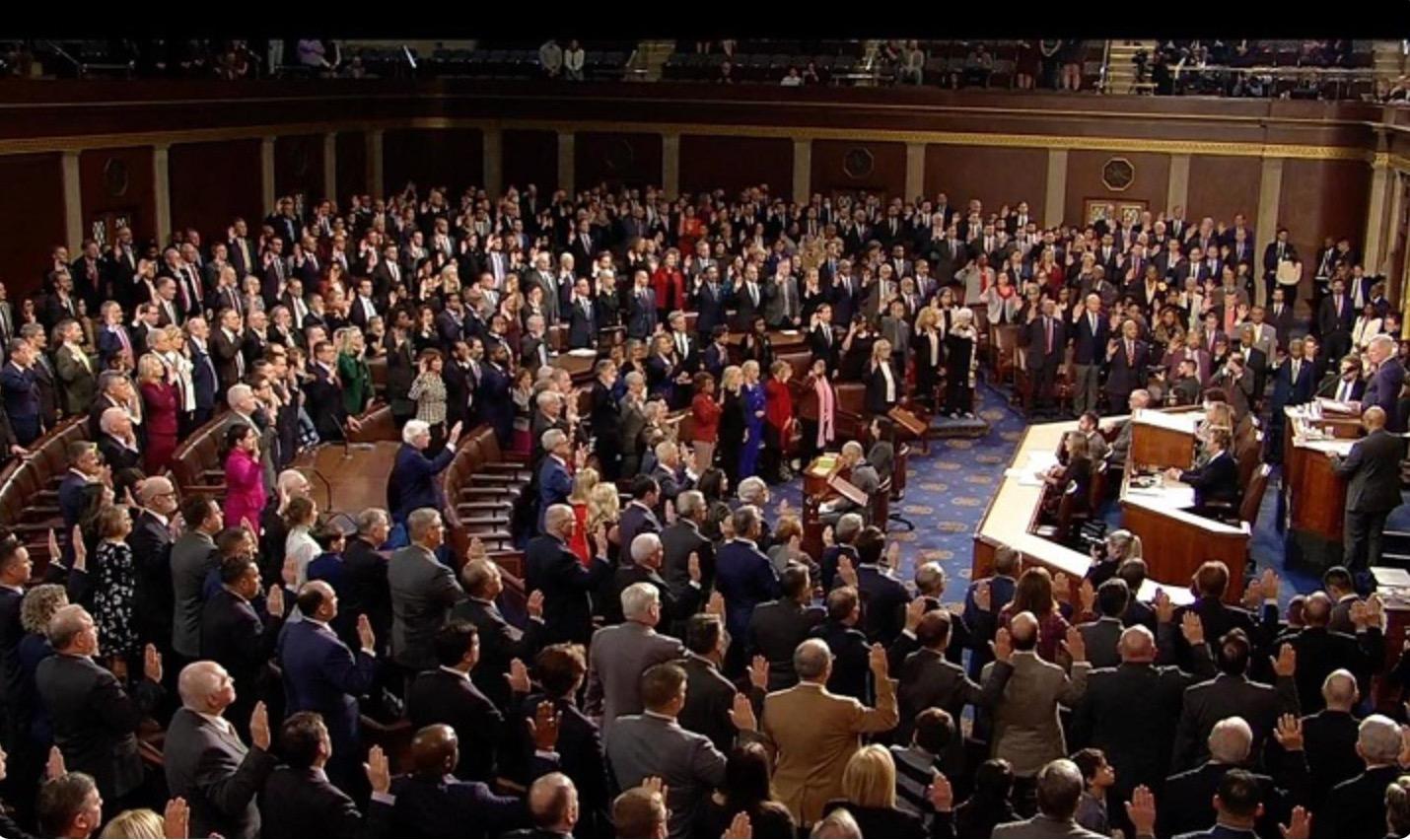
The 2024 US Presidential Primary Calendar
• January 8: Iowa Republican Caucus
• January 16: New Hampshire Primary
• January 27: South Carolina Republican Primary
• February 3: South Carolina Democratic Primary
• February 6: Nevada & New York Primary; New Hampshire Democratic Primary
• February 27: Michigan Primary
• March 5 (”Super Tuesday”): Alabama, Arkansas, California, Maine, Massachusetts, Minnesota, North Carolina, Oklahoma, Tennessee, Texas, Utah, Vermont, Virginia. America Samoa Democratic Caucuses
• March 12: Georgia, Idaho, Mississippi, Missouri, Washington State, Hawaii Republican Caucuses, Northern Mariana Islands
Democratic Primary
• March 17: Puerto Rico Democratic Primary
• March 19: Arizona, Florida, Illinois, Kansas, Ohio
• March 23: Louisiana
• March ?: Colorado (held on one of the first three Tuesdays of March – the Governor picks)
Colorado
• April 2 Wisconsin
• April 6: Democratic Primaries in Alaska, Hawaii, North Dakota
• April 13: Wyoming Democratic Caucus
• April 23: Delaware, Pennsylvania, Rhode Island
• April 30: Connecticut
• May 7: Indiana
• May 14: Nebraska, Maryland, West Virginia
• May 21: Kentucky, Oregon
• June 4: Montana, New Jersey, New Mexico, South Dakota, Washington, DC.

2024 Presidential Debate
Schedule & Party Conventions
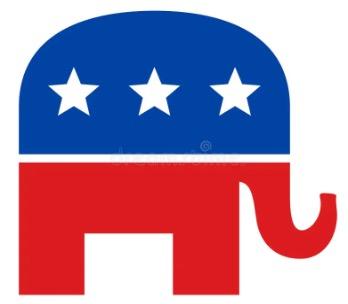
Republican Presidential Convention
• July 15-18, 2024: The Republican National Convention will be held in Milwaukee, Wisconsin.
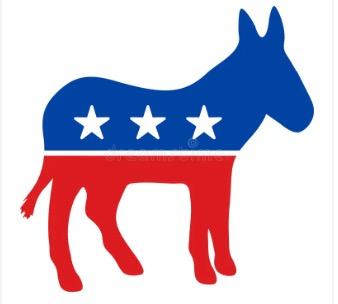
Democratic Presidential Convention
• August 19-22, 2024: The Democratic Presidential Convention will be held in Chicago, Illinois.

Schedule for Presidential Debates
• September 16 - San Marcos, Texas (Texas State University)
• October 1 – Petersburg, Virginia (Virginia State University)
The US Election 2024: Who
is Up for Election?
• Election Day: November 5, 2024
- Who is up for election?
Ø The President and Vice President
Ø 435 members of the House of Representatives
Ø 33 Members of the US Senate
Ø 11 Governors and Lieutenant Governors
Ø 10 State Attorney Generals
Ø 86 state legislatures in 44 states plus 8 legislative chambers in US Territories
Ø 22 major city mayors
Ø Hundreds of state and local judges
• January 25, 2025 – The new President and Vice President and all members of the new Congress are sworn into office.
States with Senate seats up for election
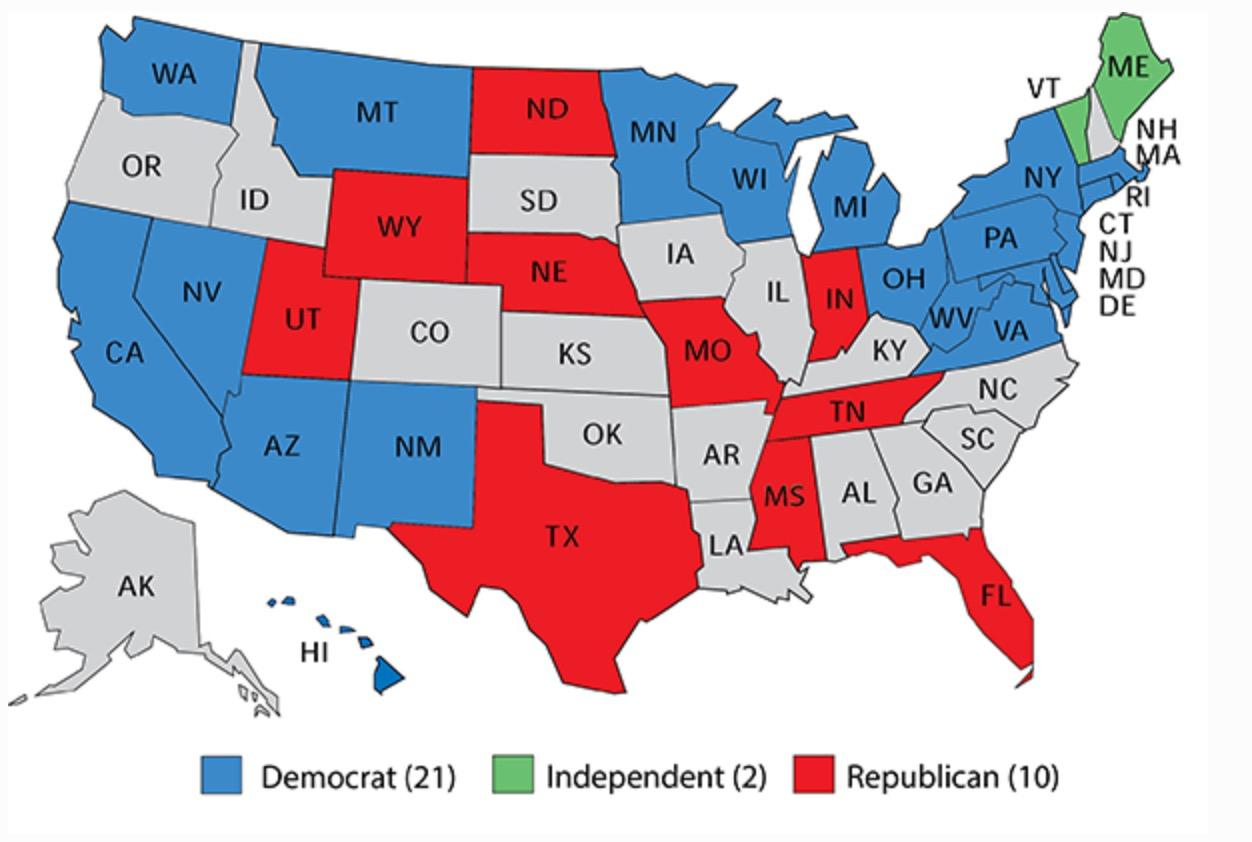
States with Governor seats up for election
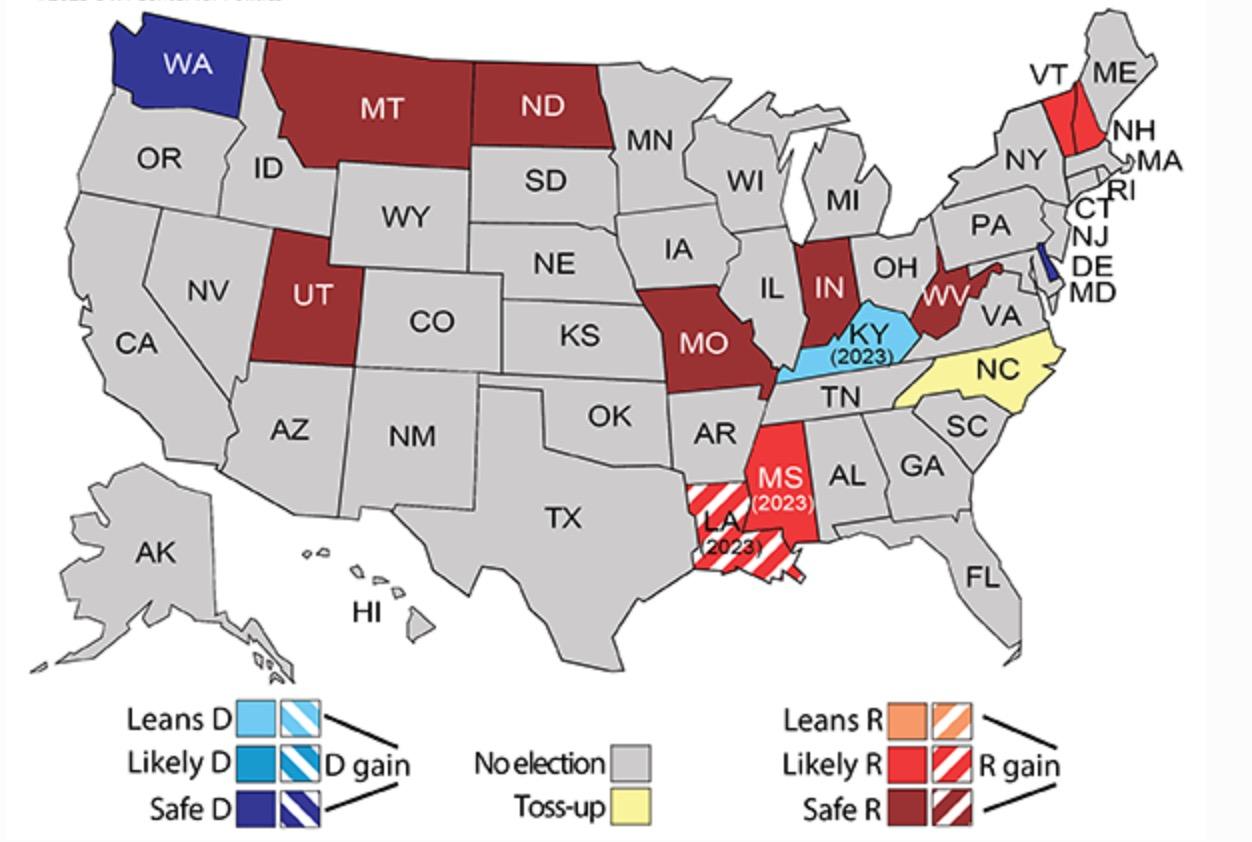
Source: University of Virginia Miller Center for Politics


Fulcrum Macro Advisors LLC Leadership

Frank Kelly
Frank is the Founder and Managing Partner of Fulcrum Macro Advisors LLC. He has worked as a senior executive on Wall Street for over 30 years, most recently at Deutsch Bank. Prior to this, he held senior positions at Charles Schwab & Co., and Merrill Lynch where he was Chief of Staff and Global Head of Marketing.
At Deutsche Bank, Frank served as Global Coordinator for Government and Public Affairs. He was also the Bank’s first Chief Political Strategist, advising clients on geopolitical and domestic policy issues.
Prior to joining the financial services sector, Frank was Chief Spokesman and Senior Policy Advisor to the Chairman of the US Securities and Exchange Commission. Previous to this, Frank served at the US Department of Justice in the Office of Policy Development where he focused on international and national security issues. He began his career as a Writer for President Ronald Reagan, going on to serve as the Deputy Associate Director of the Office of Political Affairs. He remained at the White House to serve as a Writer for President G. H. Bush.
He is also a Senior Advisor to The Scowcroft Group, a Washington DC global business advisory firm with an emphasis on emerging markets. He is also a Senior Associate in the Americas Program at the Center for Strategic and International Studies (CSIS). Frank additionally is a Lecturer at The Catholic University of America’s Busch School of Business where he teaches on Business Intelligence.
Francis j. Kelly
Direct: +1-202-744-5706
Email: fkelly@fulcrummacro.com
www.fulcrummacro.com
Frank is a member of the Council on Foreign Relations, the International Institute for Strategic Studies, the American Council on Germany and American Institute for Contemporary German Studies. He also serves on the Board of Directors of Codespa America and as Vice Chair of the Board of Directors of the Jerome Lejeune Foundation of America.
He resides outside Washington DC in Great Falls, Virginia with his wife, Maura, on their working farm, Open Door Farm.
